Plan the ultimate day trip from Osaka to Hiroshima to check out some of the city’s most important historic sites. Plus, we’ll share unique things to do in Hiroshima, how to get to nearby Miyajima Island for free, as well as some of the special foods you should try in this region.
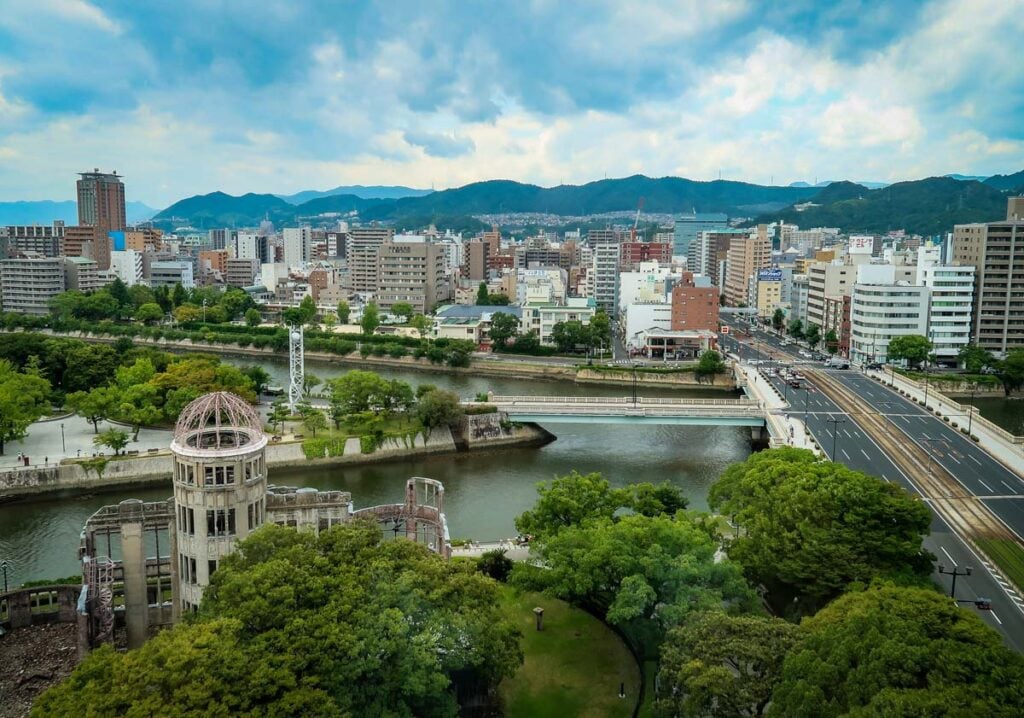
Visiting Hiroshima is a popular day tip on many Japan itineraries, and not for the same reason most other cities make the cut…
While there is certainly food to try and fun things to do here, these are not the reasons most visitors come here. Hiroshima is most well-known for its dark past — as ground zero for the first atomic bomb.
While the city’s stark history is incredibly important to take in and learn about while you’re there, we’d also recommend enjoying some of the ways the city has flourished in recent times by appreciating the modern infrastructure, exploring the thriving downtown district, and experiencing the city’s burgeoning food scene.
Whether you’re a true history buff or you recently watched Oppenheimer and got your curiosity piqued, taking a day trip to Hiroshima is an important part of experiencing the history of not just Japan, but our world.
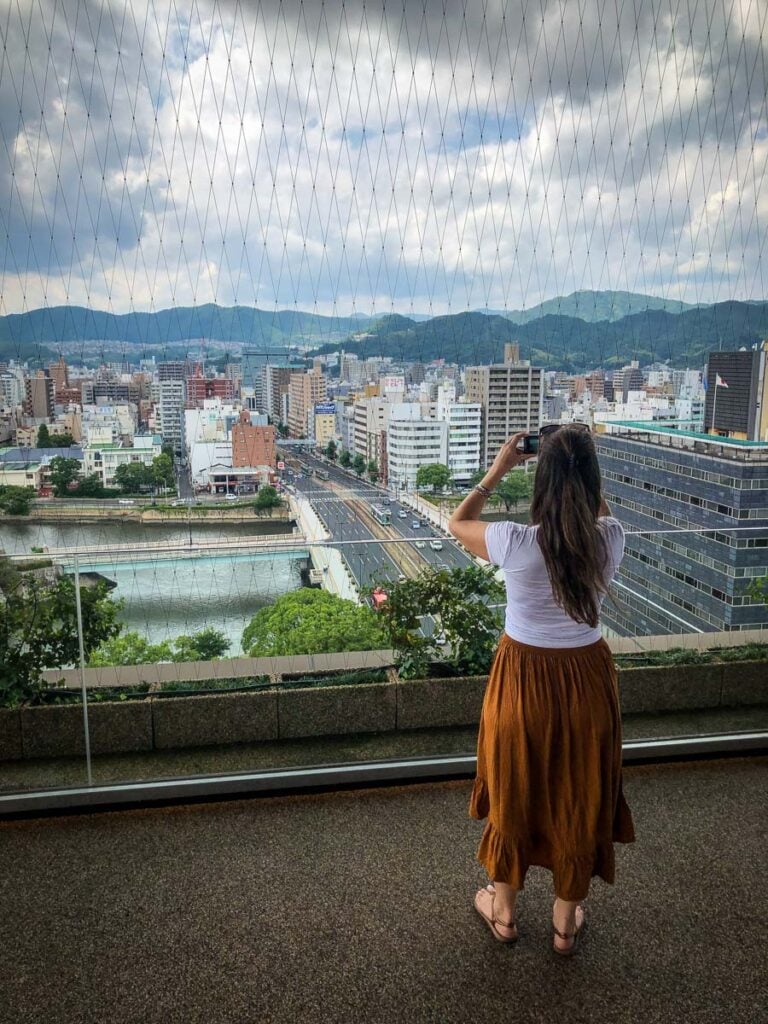
In this article, we’re going to share how to get from Osaka to Hiroshima for a perfect day trip, including exactly how to spend your time once you’re there.
We’ll go over the important historic sites you can easily see on a day trip, and some of the more unique things to do in Hiroshima, should you choose to stay the night.
We’re even including how to get to nearby Miyajima Island for free, as well as some of the special foods you should try in this region.
Hiroshima day trip guide
- Hiroshima day trip itinerary
- How to get there:
- History
- Things to do
- What to eat
- Where to stay
Psst! If you’d rather experience nature on a day trip from Osaka, we think you’ll love Minoo Park!
Hiroshima day trip itinerary
With just a day, this is the itinerary we’d personally suggest. Click each link to see the activity in further detail.
- Arrive by train in the morning (book these tickets in advance)
- Grab a quick breakfast at Wildman Bagel, which specializes in bagels stuffed with cream cheese and other fillings
- Experience Hiroshima Peace Memorial Museum
- Explore Hiroshima Peace Park
- Check out Children’s Peace Monument
- See the Atomic Bomb Dome
- Enjoy Hiroshima-style okonomiyaki for lunch
- Okonomiyaki Teppan-yaki Momiji-Tei: small eatery with manga theme
- Nagataya: famous okonomiyaki spot with vegan options
- Okonomimura: food hall with lots of okonomiyaki stands to choose from
- Return to Osaka (or wherever you’re staying) via train
- When you’re at the train station, pick up some momiji manju
Have more time in Hiroshima? Read through our entire list of things to do for more ideas of how to spend your time in Hiroshima.
How to get from Osaka to Hiroshima
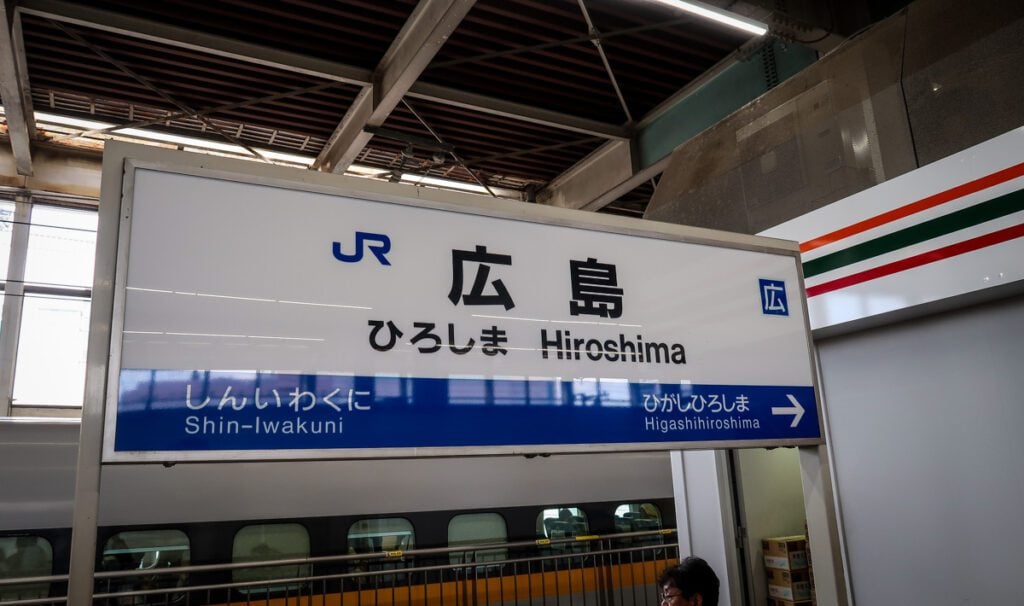
Situated on Japan’s Honshu island, it is possible to visit Hiroshima as a day trip from Osaka.
But there’s also enough to do to in this city that it might be worthwhile to extend your stay and spend the night.
Here are directions from Osaka to Hiroshima:
a) Osaka to Hiroshima by Shinkansen Train
Yes, you can travel from Osaka to Hiroshima with a JR Pass on a Shinkansen train.
Hiroshima is just 1 hour and 40 minutes west from Osaka on the Tokaido-Sanyo Shinkansen train (which is covered in your JRail pass), making it a great place to visit on a day trip.
You’ll board the bullet train in Osaka at Shin-Osaka Station and ride west towards Hiroshima Station.
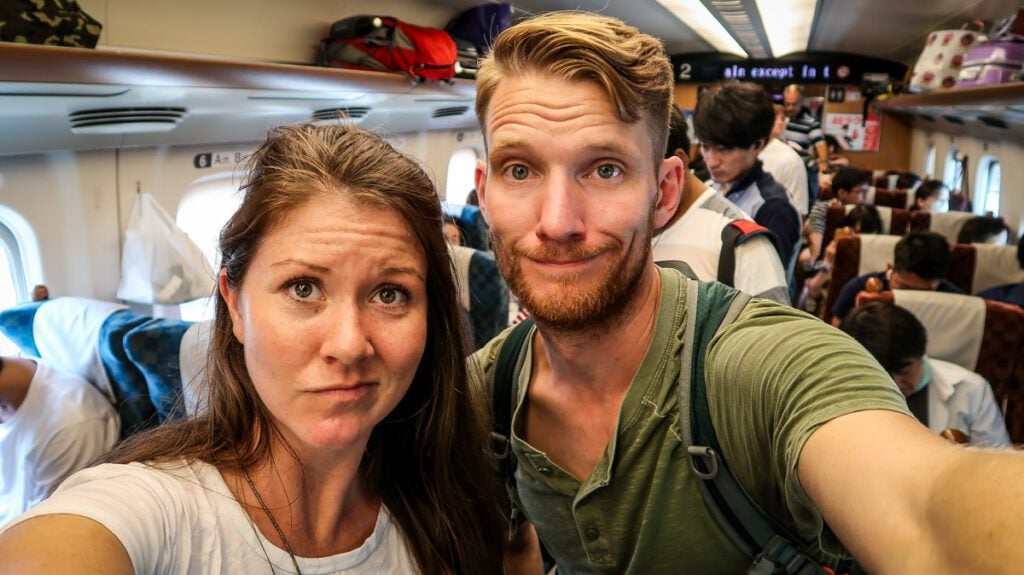
Insider Tip: This route is very popular, so be sure you book your JR tickets in advance (we recommend at least one day in advance). We didn’t book ours soon enough, and had to stand for the majority of the nearly 2-hour journey. Don’t make the same mistake we did!
b) Osaka to Hiroshima by Bus
You can also find regular daytime and overnight buses from Osaka to Hiroshima. The buses will depart from Osaka Station JR Express Bus Terminal and take about 5 hours to reach Hiroshima. You can book your tickets directly at JR Expressway Bus Ticket Center on the 1st floor of Osaka Station. Fares will vary based on the service, but should be around ¥4,000 – ¥6,000.
Tip: We’d recommend looking into purchasing a JRail pass and taking the train to cut down on travel time. Especially if you plan to make Hiroshima a day trip from Osaka, you’ll want to maximize your time there.
Psst! Check out our ultimate 2 day Osaka itinerary, which has all of the logistics and details planned for you!
c) Self drive
If you have a rental car in Japan, you’ll have a straightforward journey.
Wondering how to get to Hiroshima from Tokyo or Kyoto? Jump here for directions!
Brief History of Hiroshima
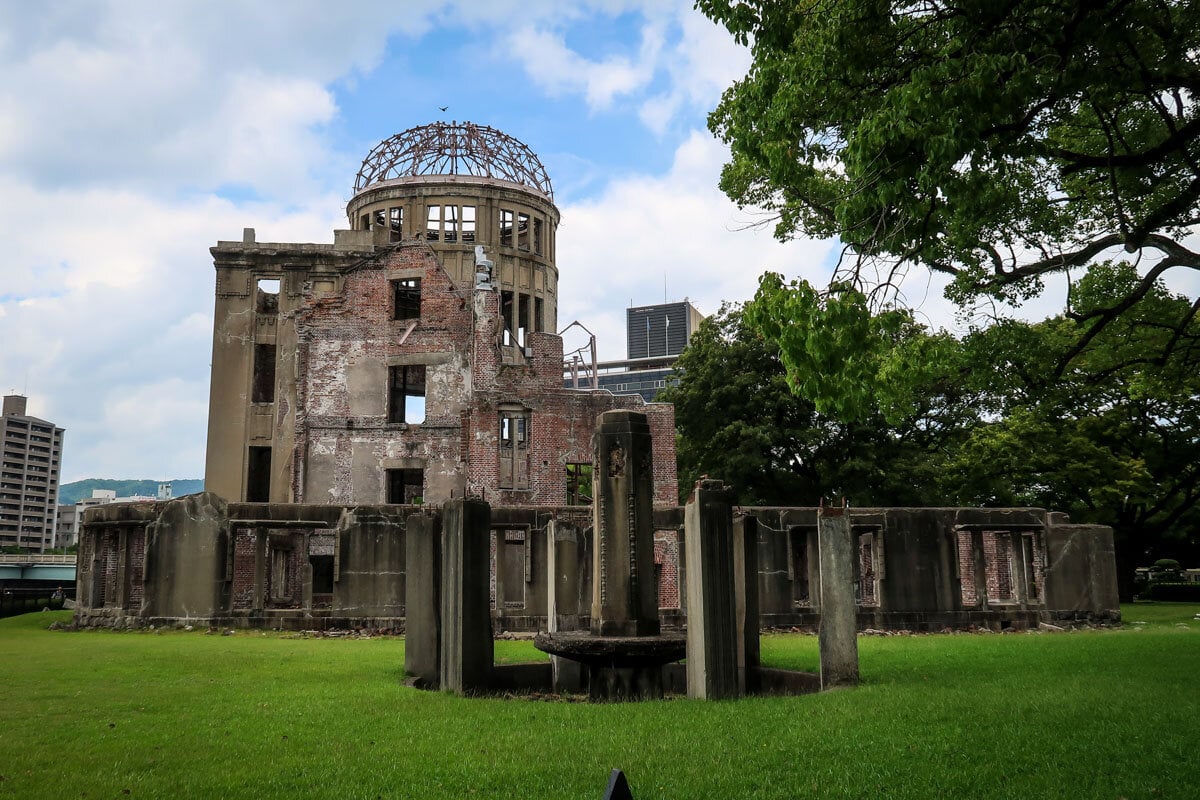
Hiroshima history at a glance:
- pre WWII: major industrial hub
- during WWII: supply and logistics base for the Japanese Imperial Army
- December 7, 1941: Japanese military launched a surprise attach at Pearl Harbor (United States Naval Base in Hawaii), killing 2,403 people (mostly military personnel).
- August 6, 1945: the world’s first atomic bomb was dropped on Hiroshima, immediately killing 80,000 people
- September 2, 1945: Japan surrendered from the war
- 1949: Japanese parliament declared Hiroshima a City of Peace and chose a design for a Peace Memorial
- 1955: Hiroshima Peace Memorial Museum was opened
- Today: Hiroshima is an iconic location for holding international conferences on promoting peace
More detailed history:
Strategically situated on the Ōta River delta, Hiroshima was once a major industrial hub and center of military activities during the Imperial Era in Japan.
During World War II, the city acted as a supply and logistics base for the Japanese Imperial Army and headquarters for the branch in commanding the defense of all of southern Japan. It is this reputation that lead to the city’s destruction and ultimately solidified its place in history as the site of the first ever atomic bomb during World War II.
Atomic bombing of Hiroshima
The war in Europe had ended when Germany signed it’s official surrender on May 8, and the allied countries turned all of their focus on the Pacific. The United States detonated the first nuclear weapon over the city of Hiroshima at 8:15 a.m. on August 6, 1945, the final year of World War II.
The attacked wiped out nearly 90% of the city and immediately killed 80,000 people — mostly civilians. Tens of thousands of people would later die due to radiation exposure.
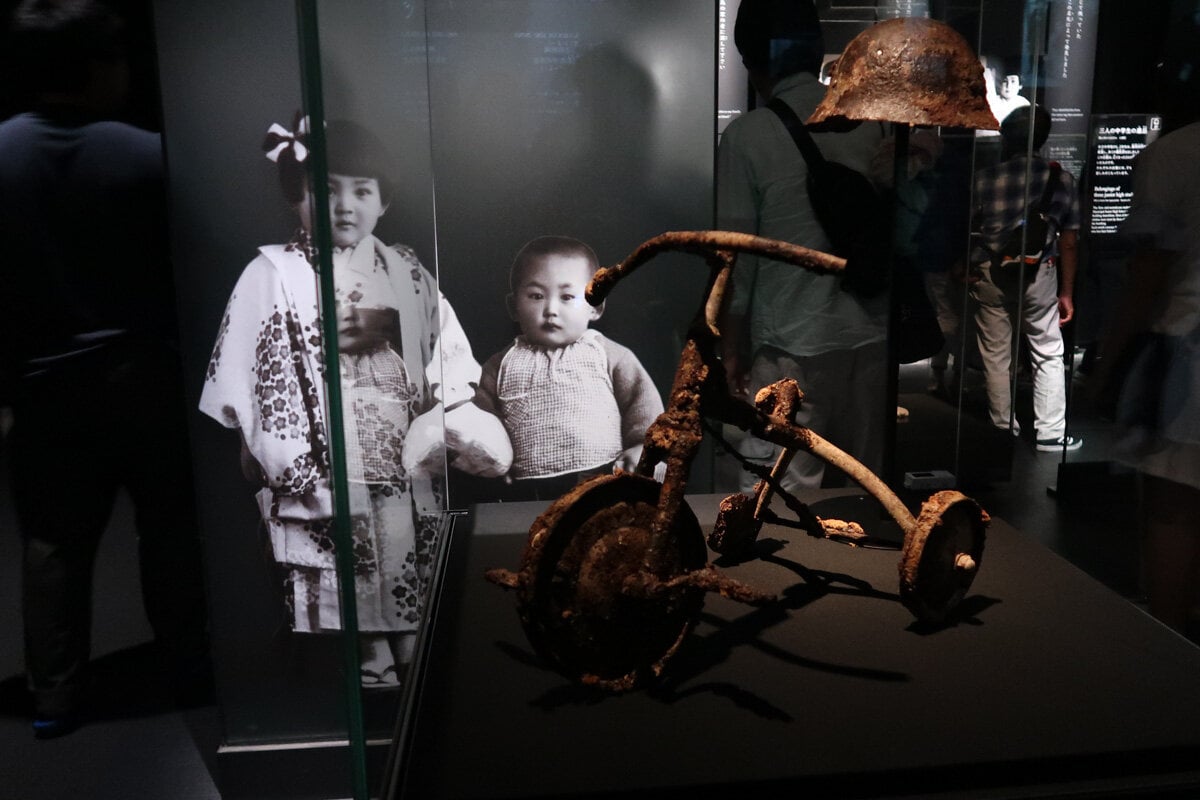
The Japanese Emperor Hirohito later announced his country’s unconditional surrender as a result of the devastation caused by the unprecedented attack.
The Japanese parliament later declared Hiroshima a City of Peace, and in 1949, a design was selected to build the Hiroshima Peace Memorial Park.
The Hiroshima Prefectural Industrial Promotion Hall was the closest surviving building to the center of the bomb’s destruction and was left erect as part of the memorial, designated the “Atomic Dome”. Then, in 1955 the Hiroshima Peace Memorial Museum was opened.
Today, Hiroshima receives international attention not only for it’s devastating history, but as a iconic location for holding international conferences on promoting peace and social issues. The city government continues to fight to abolish nuclear weapons and the Mayor of Hiroshima is acting president of the Mayors of Peace, an international organization of Mayors promoting peace.
Fun things to do in Hiroshima
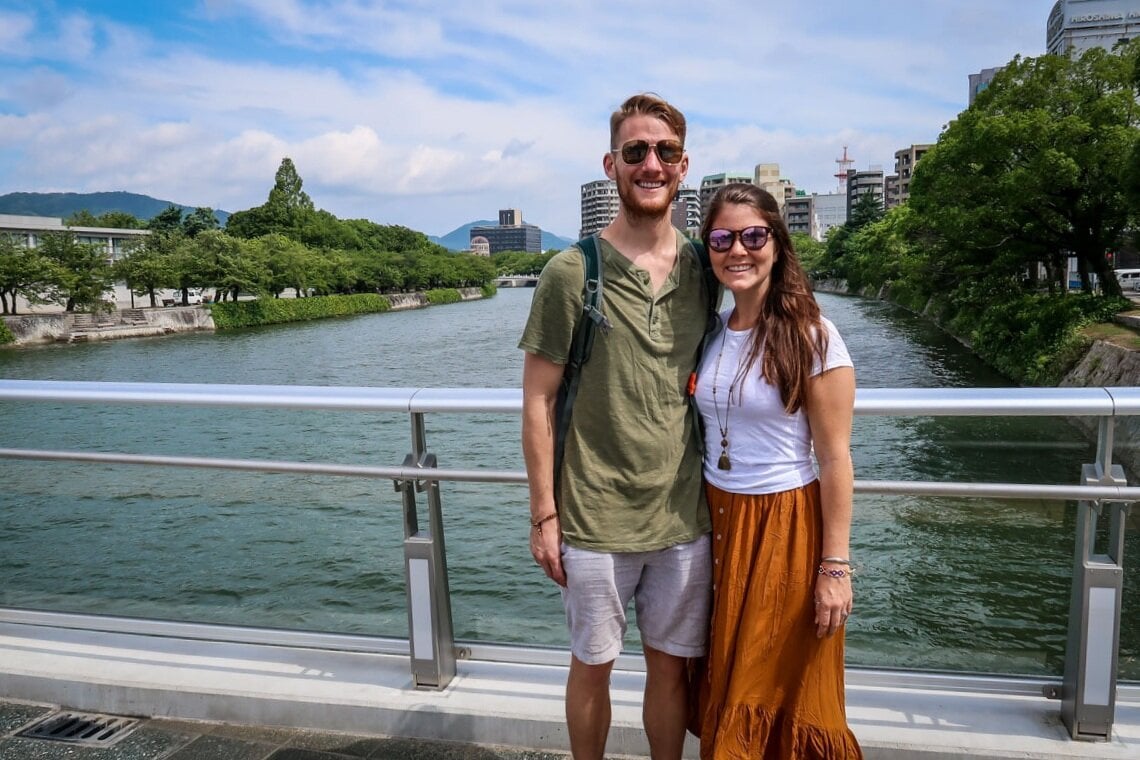
Whether you have a few hours in Hiroshima or a few days, we’ve laid out the best things to do in this city.
With limited time, we’d suggest sticking to #1-4 on this list, as they are the most important WWII sites in the city and will make up a perfect “DIY walking tour of Hiroshima”.
Touring the museum and walking around the park can take about half a day and it’s totally doable on your own as there there are many signs in English.
If you have more time, continue down the list. Oh, and don’t forget to try some of the regional cuisine in Hiroshima (more on that later!).
1. Visit the Hiroshima Peace Memorial Museum
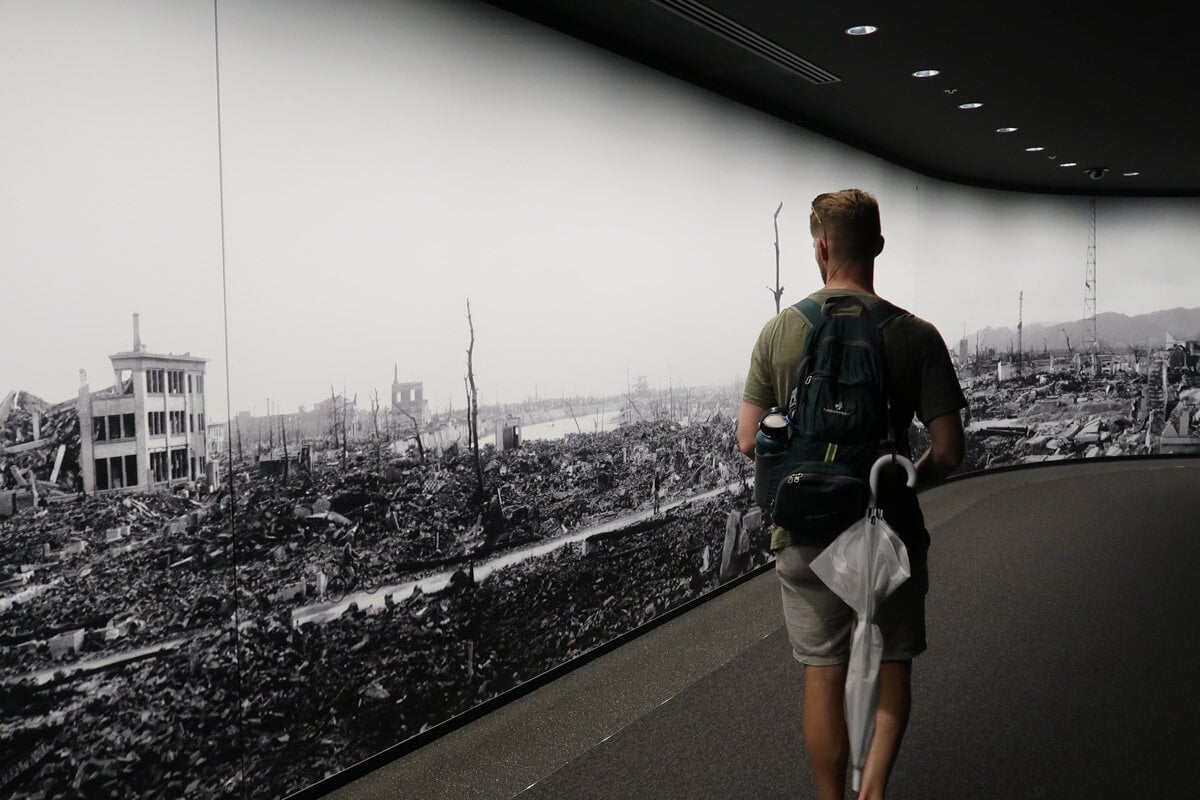
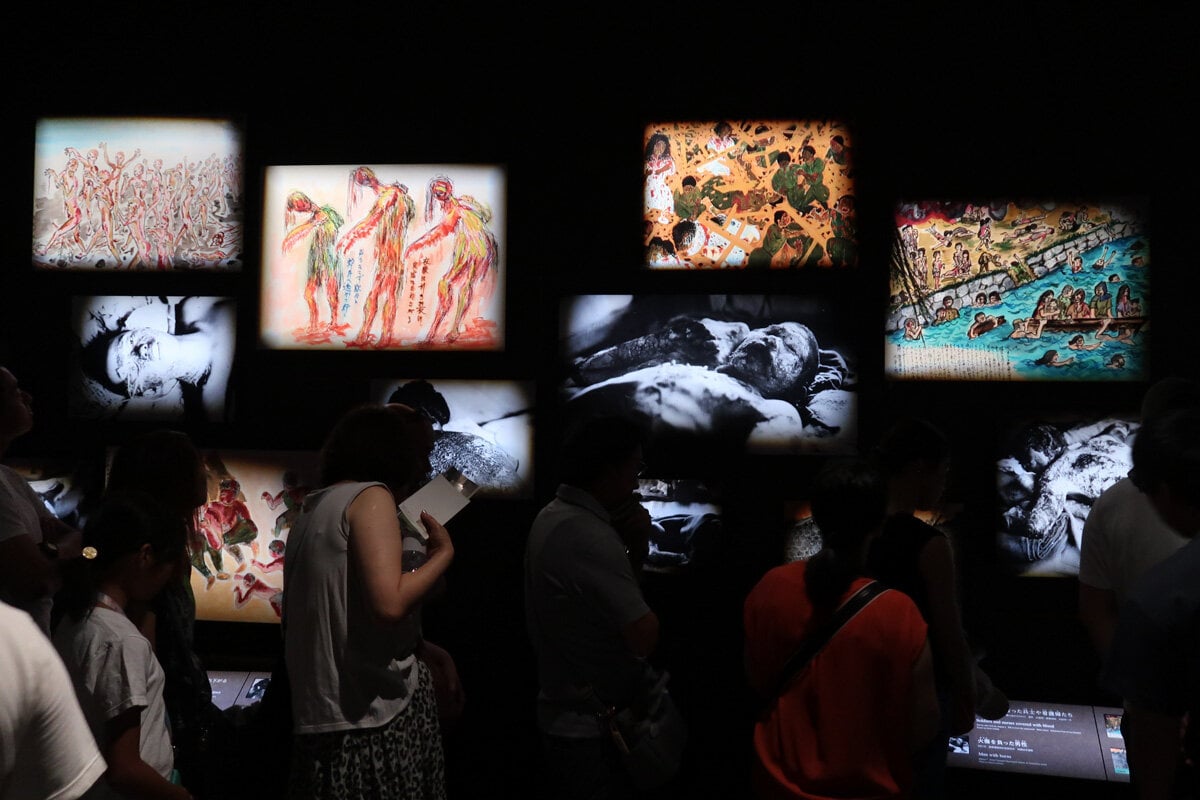
Newly renovated, this museum displays the horrors and devastation the atomic bomb had on Hiroshima and it’s people.
Through artifacts, belongings and personal stories of victims of the catastrophic attack, the museum demonstrates the inhuman nature of an atomic bomb and seeks to spread the message of “No More Hiroshimas”.
Good to know:
- Cost: Entry is just ¥200 (~$2 USD) for adults
- Hours: Open 7 days a week from 7:30 a.m. – 7 p.m. most of the year
- (Dec-Feb they close at 6 p.m., during August, it’s open until 8 p.m.)
2. Hiroshima Peace Park
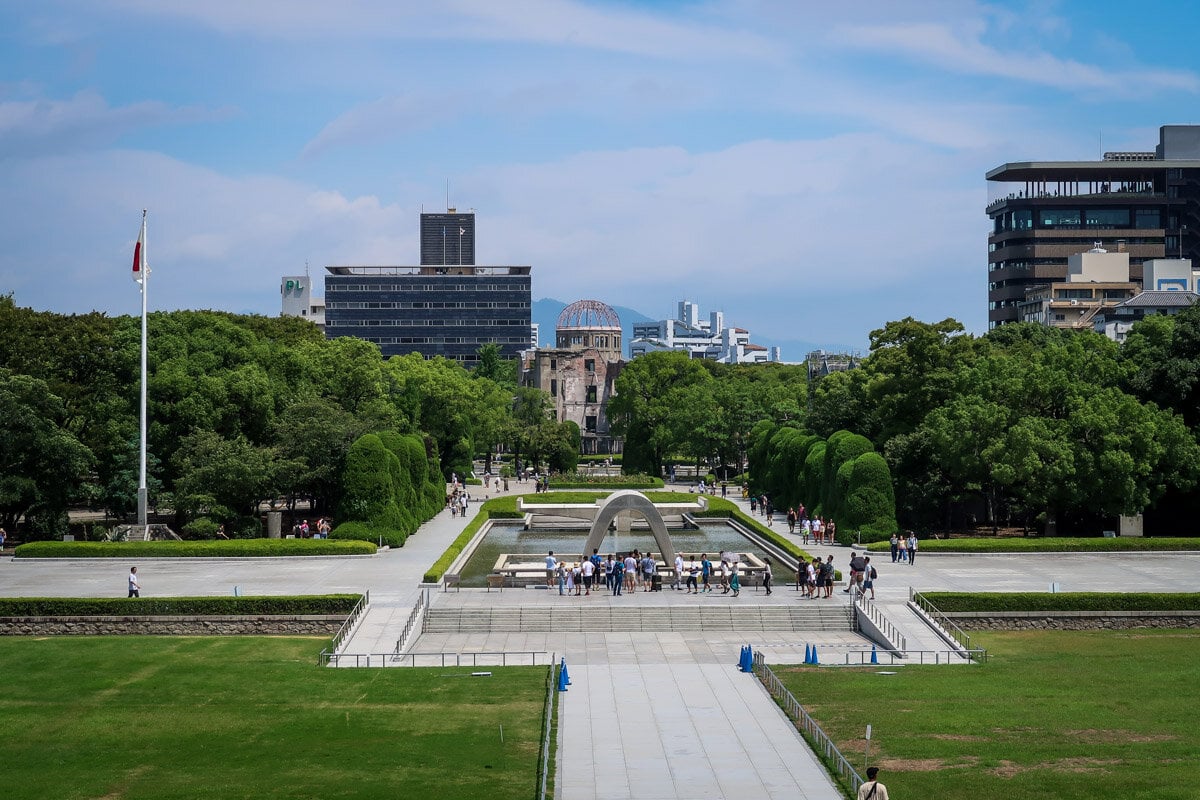
This open park in the center of Hiroshima is dedicated the victims of the atomic bomb.
Within the park, you’ll see many different monuments, art installations and memorials:
- Fountain of Prayer: Situated at the museum entrance, this fountain is dedicated to all those who were lost. It is said that after the bombing, many victims lay crying out for water in their final moments, so this fountain is meant to be a somber tribute.
- Peace Memorial Hall for the Atomic Bomb Victims: This quiet hall is meant to be a place where visitors can read memoirs and poems and watch testimonial videos from survivors.
- The Cenotaph: This arched concrete structure is hard to miss. Inside it are registries of all known victims of the atomic bomb, and there is an etched inscription that reads: “Let all the souls here rest in peace, for we shall not repeat the evil.”
- Peace Flame: Near the center of the park, you’ll see a flame that is said to stay lit until all nuclear weapons on earth are gone.
- Atomic Bomb Memorial Mound: This grassy mound holds the bodies of 70,000 people who were mass cremated.
- Peace Bell: You can ring this bell, which sits over a lily pad-covered pond.
3. Children’s Peace Monument
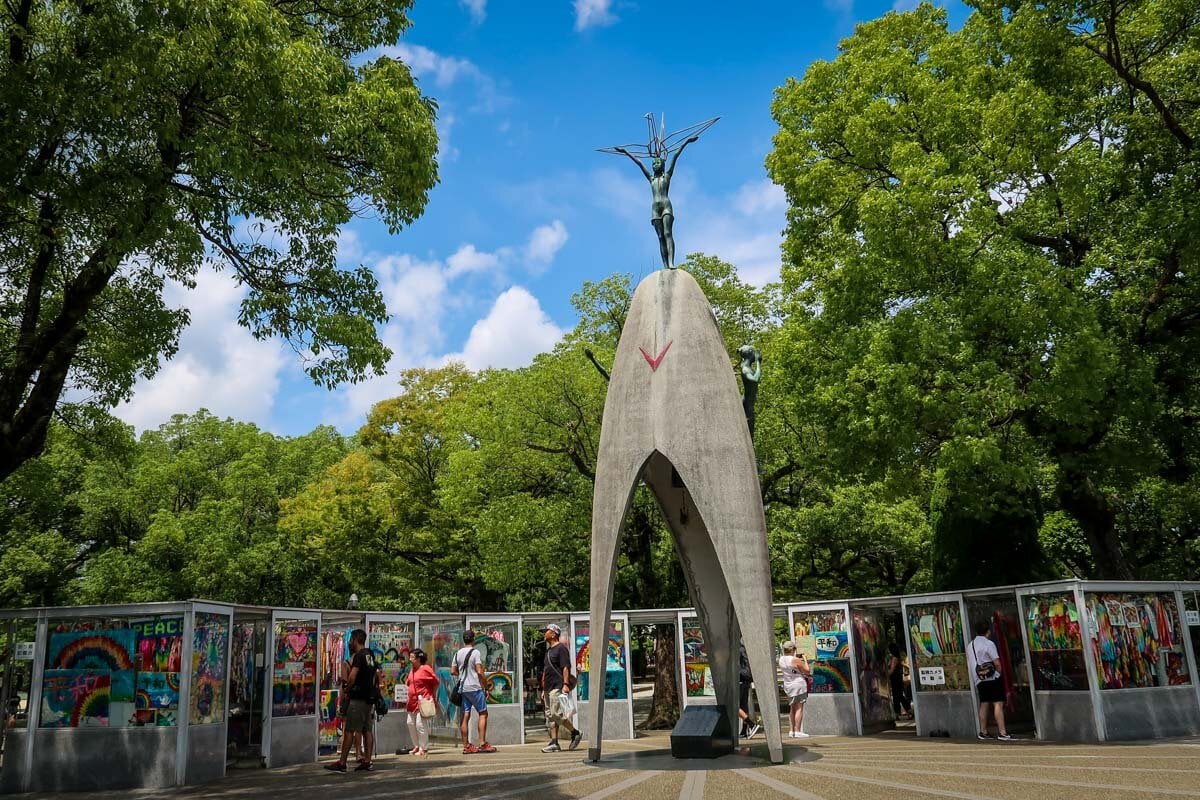
Filled with paper cranes, this monument is dedicated all the children who lost their lives due to the bomb.
The paper cranes pay homage to the true story of Sadako Sasaki — a Japanese girl who was just two years old when the atomic bomb was dropped on her home. She was exposed to the radiation of the blast and diagnosed with leukemia caused by her exposure.
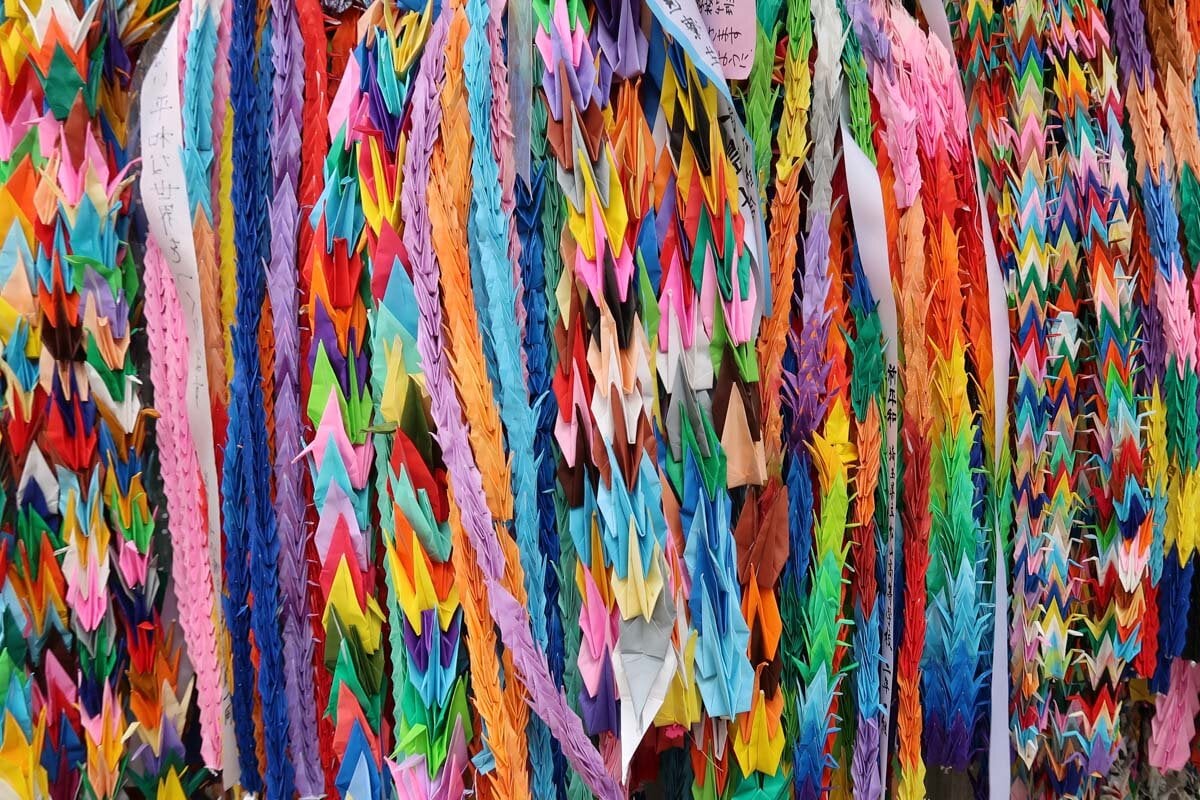
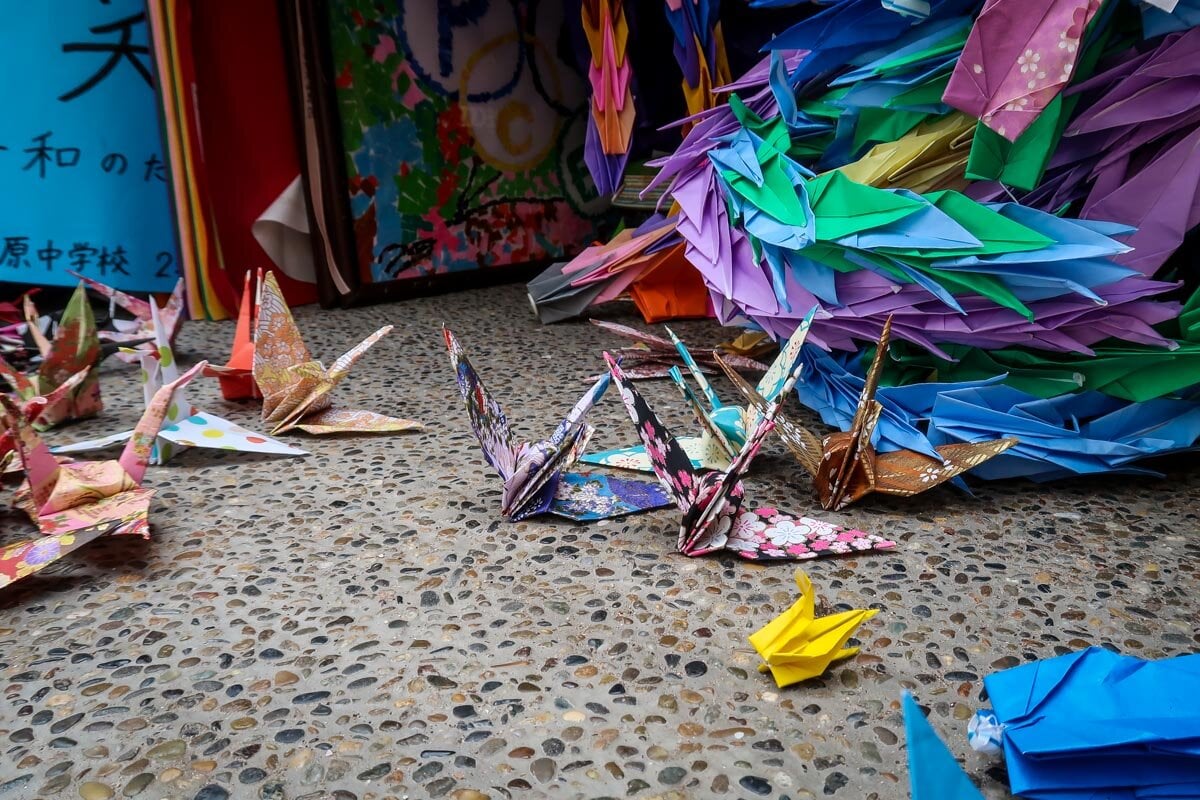
Japanese legend has it that one who folds one thousand origami paper cranes will be granted a wish. Believing this legend, Sadako started folding the cranes as she fought for her life with one simple wish in mind: to overcome her illness so she could fulfill her dream of joining the running team.
She died at age 12 having only completed 644 of the cranes before the leukemia took her. Her friends and family completed folding the remaining 356 paper cranes to be buried with her.
Sadako can be seen at the top of the monument holding a “paper crane” above her head. Onlookers add their own paper cranes to the monument symbolizing the continued pursuit of peace.
4. Atomic Bomb Dome
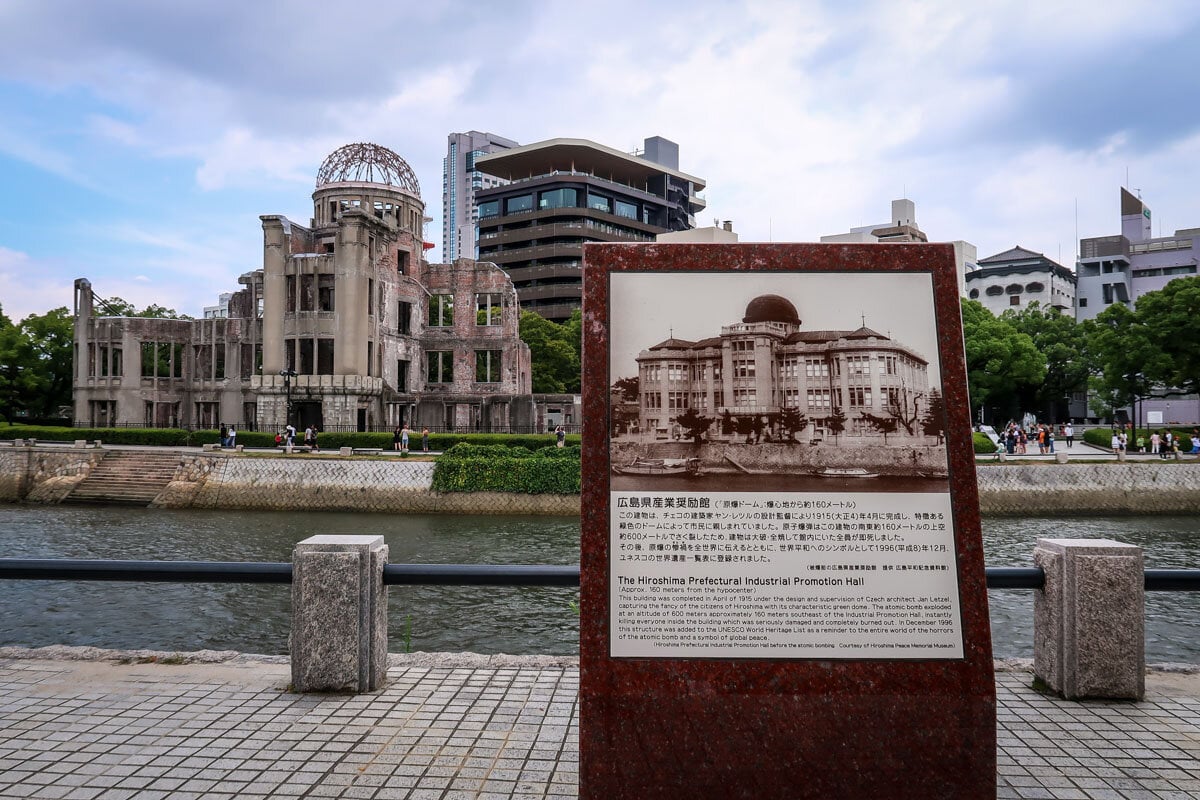
Once a convention center, the Hiroshima Prefectural Industrial Promotion Hall was one of the only structures still standing after the bomb’s blast.
The hypocenter of the bomb was only a few blocks away, so it is one of the most iconic sights in Hiroshima today.
5. Get a view above the city
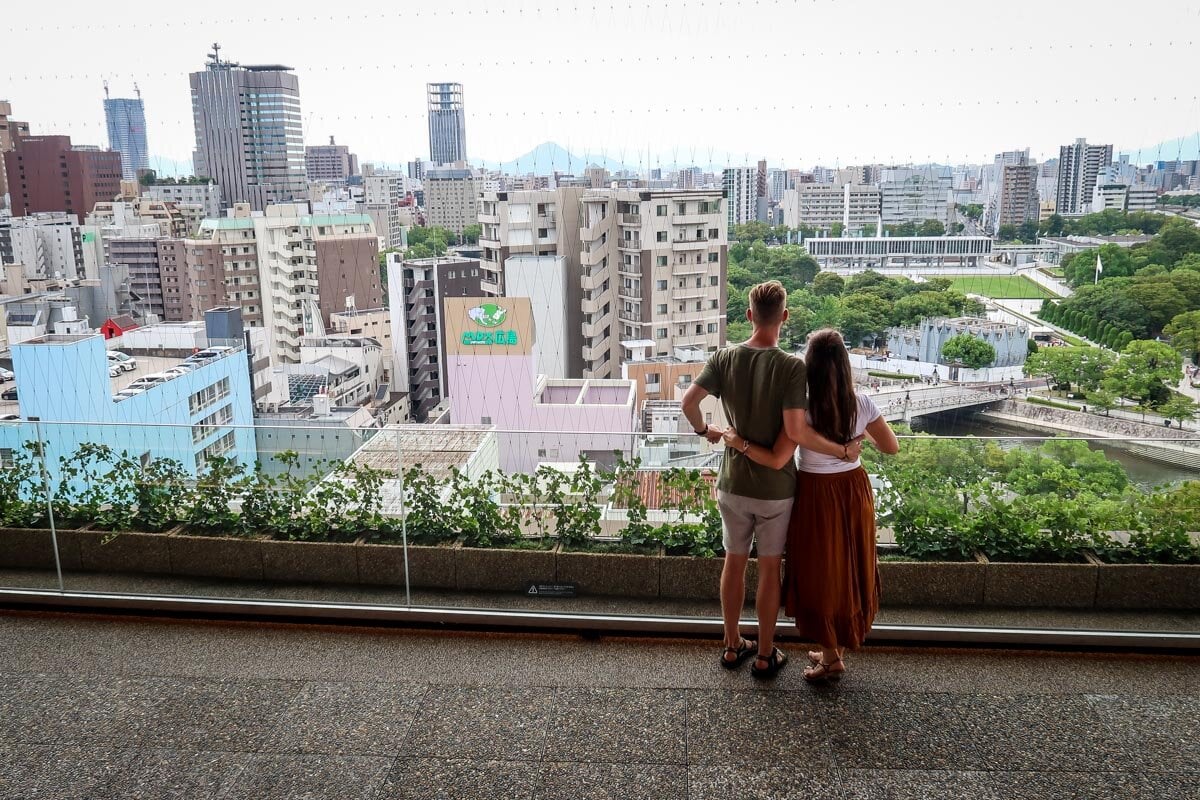
If you’re a fan of getting a bird’s eye view, Hiroshima Orizuru Tower is where you’ll find the best panorama in the city.
The view over Hiroshima is pretty impressive, and this place isn’t very crowed. It’s also nice that they let you bring food and drinks to the top to have your own little “picnic with a view”.
However, at ¥1,700 per adult, the entrance fee to get to the top isn’t cheap, so if you’re traveling to Japan on a budget, you might want to skip this stop.
Our personal experience: This was included in our guided tour with Magical Trip (more on that below), but if we were to do it again on our own, we would probably skip this part as expensive viewpoints aren’t totally our thing.
6. Make your own paper crane
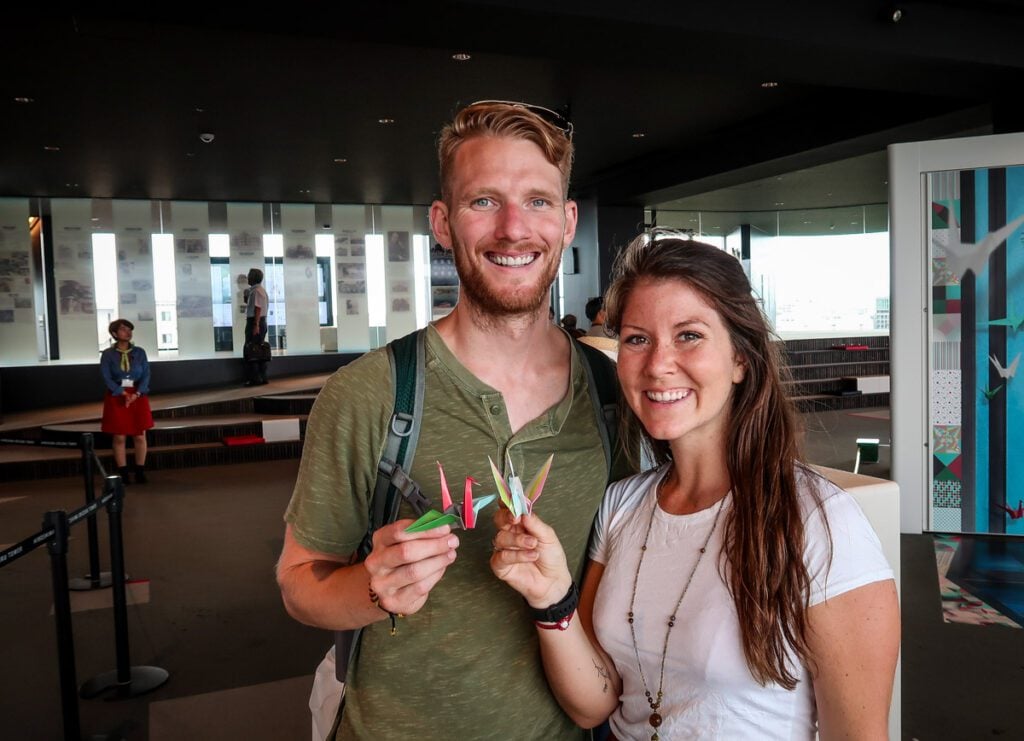
If you go to the Hiroshima Orizuru Tower (see above), included in the entrance fee is paper to make your own crane.
There are stations around with instructions to fold your own paper crane.
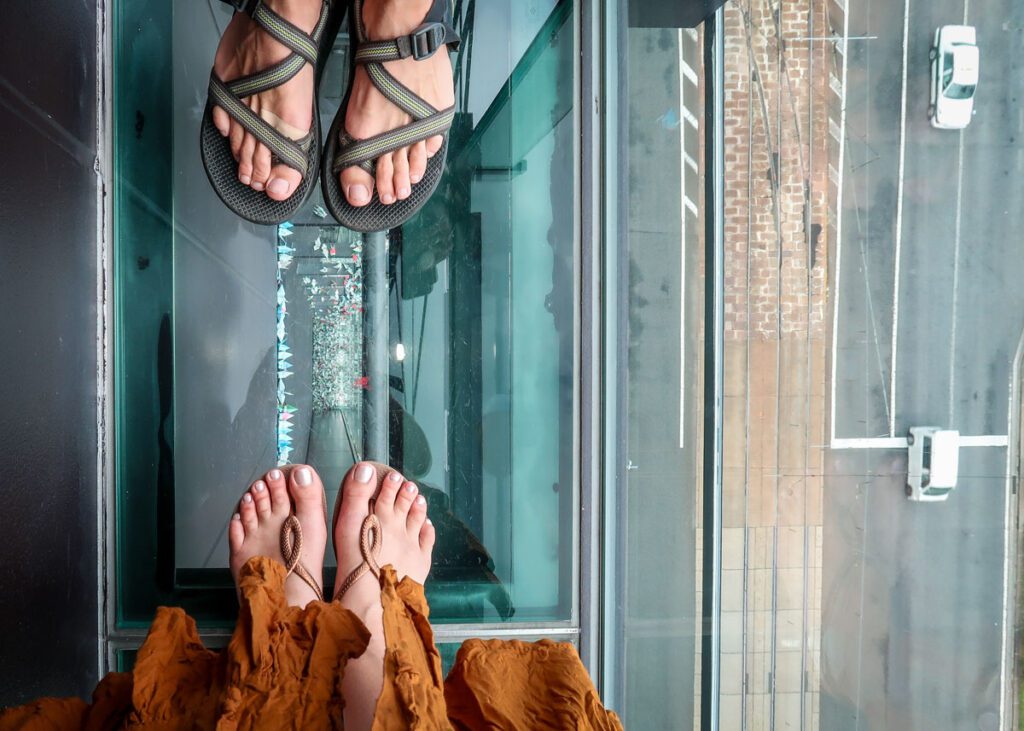
Once completed, you can drop it through a hole on the side of the building and watch it “fly” down several stories into a glass case full of other paper cranes.
7. Explore the Hiroshima Castle
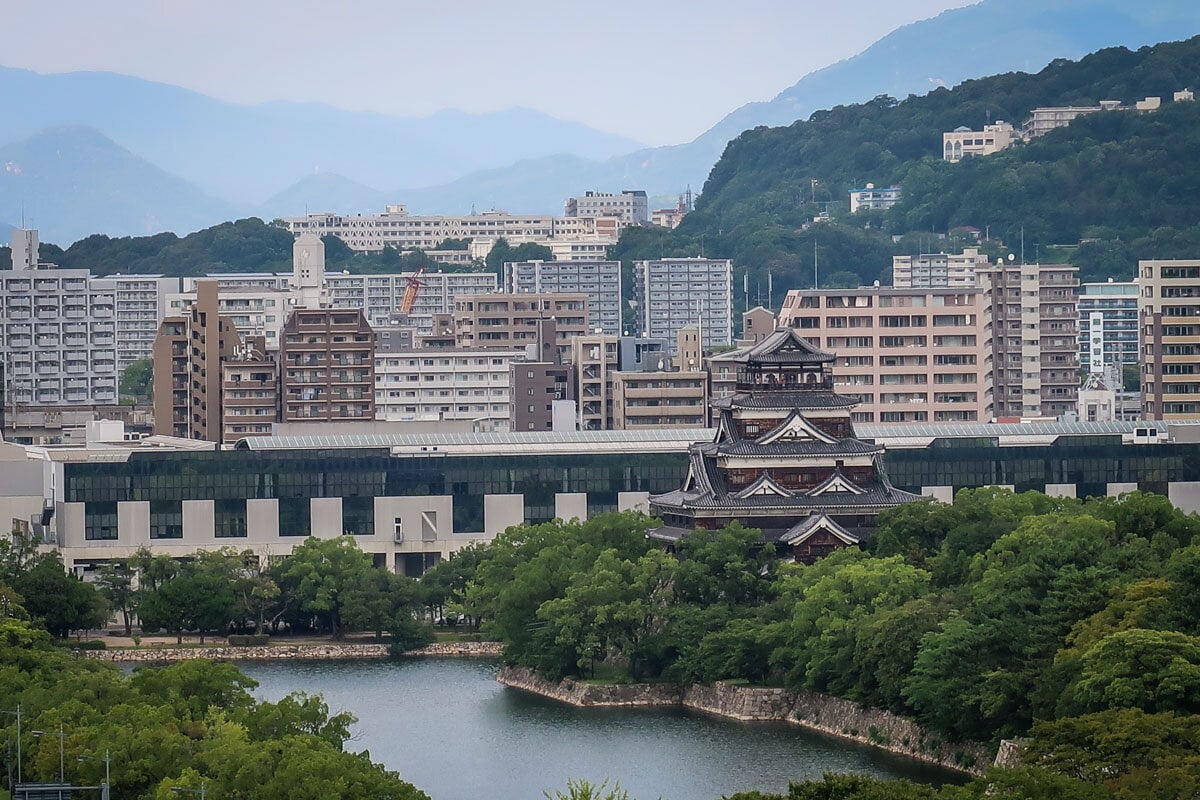
Originally constructed in the 1590’s, the Hiroshima castle was rebuilt in 1958 as a replica to the original after it was destroyed by the atomic bomb in WWII.
Just a 15-minute walk from the Peace Park, you can stroll the castle grounds and take photos for free or pay the ¥370 fee to enter the main keep which is 5 stories tall.
8. Gokoku Shrine
A large shrine next to Hiroshima Castle that is the center of many religious and cultural ceremonies in the city.
The original shrine was established in 1869 to mourn the victims of the Boshin War. As with most things in the city, the Gokoku Shine as it came to be known was destroyed by the bomb. In 1965 the shine was rebuilt within the confines of the castle, with the help and donations of the citizens of Hiroshima.
9. Wander around Shukkeien Garden
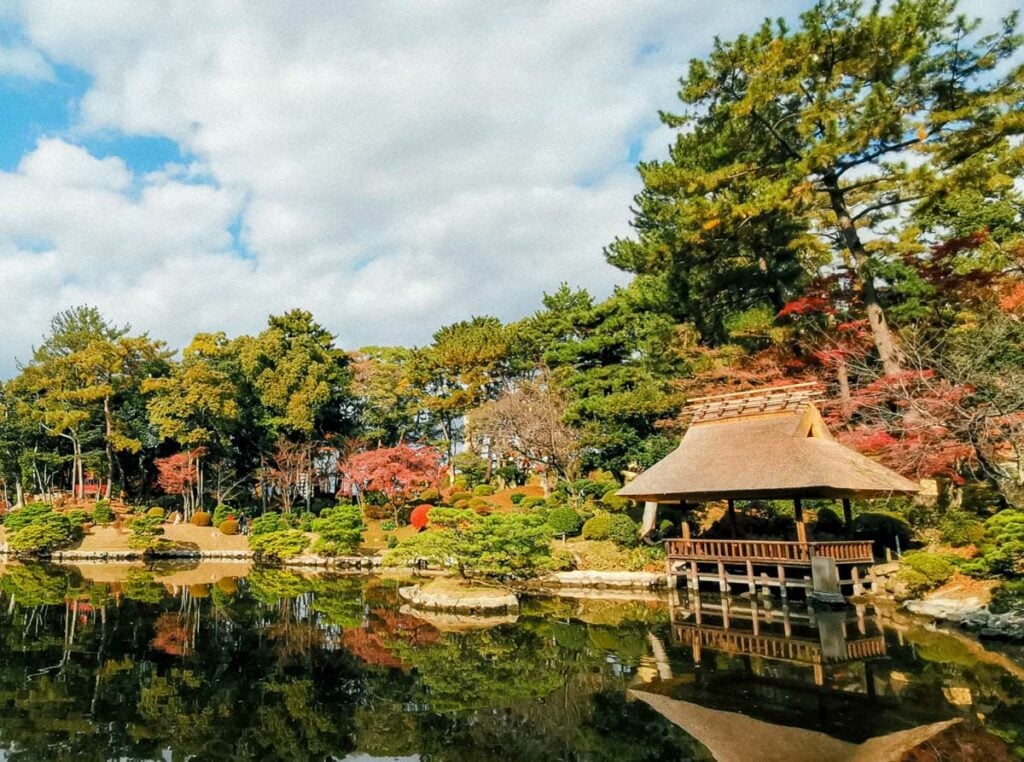
When translated into English, “Shukkeien Garden” becomes “shrunken scenery garden”. As you walk through the gardens, you’ll notice the landscapes mimic natural formations such as mountains, valleys and forests in miniature versions.
For an entrance fee of ¥260, you can meander through the traditional Japanese gardens on a path that winds around the central pond. There are also a number of tea houses that offer visitors a relaxing space to enjoy the scenery.
10. Visit Miyajima Island
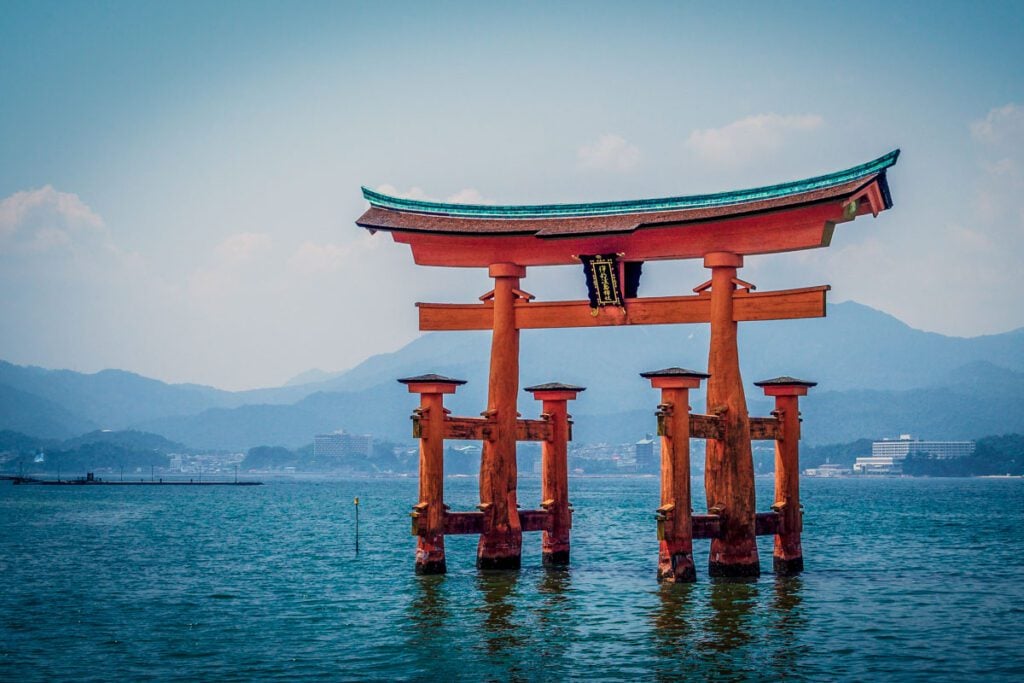
A small island in Hiroshima Bay, officially named Itsukushima, is more commonly known as Miyajima Island, which is Japanese for “shrine island”.
Miyajima is known for its picturesque floating tori gate, wild deer, and beautiful views from Mount Misen which can be reached on foot or by cable car. It is the perfect place to spend the afternoon or an overnight while visiting Hiroshima.
How to get there: You will board a train at Hiroshima Station for the 26-minute ride on the JR Sanyo Line to Miyajimaguchi. Trains depart every 15 minutes or so, so you won’t have to wait long. From Miyajimaguchi you’ll have to walk for about 2 minutes to the ferry terminal and board the JR Ferry bound for Miyajima Island (free with your JRail pass!), which takes about 10 minutes each way.
Things to do in Miyajima Island:
- Hike (or take the cable car) to Mount Misen
- plan for it to take 1.5 – 2 hours to reach the summit on foot
- Visit Itsukushima Shrine, the famous floating Tori Gate
- It was under construction when we were visiting, so be sure to look up its current condition.
- Also, make sure you visit during high tide, otherwise the gate won’t appear to be floating in the water.
- Spot the wild deer that can been seen on the island’s walking paths.
11. Experience Hiroshima Nightlife
Spending the night? Head out on the town to experience the young and vibrant nightlife scene this city is becoming more and more known for.
Unfortunately for us, we only had time for a day trip in Hiroshima, so we were unable to experience the nightlife. However, if you have the time, head to the Nagarekawa neighborhood where you can wander around and pop into any izakaya or pub that strikes your fancy.
Or, get out Google Maps and try a couple of the places below and let us know your favorites!
- If you’re looking for sake, Flat Sake Bar looks top-notch.
- For creative cocktails and a speakeasy atmosphere, we’d pop into Bar Alegre.
- Craving craft beer? Sample some Japanese brews at Raku Beer or Hangout.
Guided tour of Hiroshima
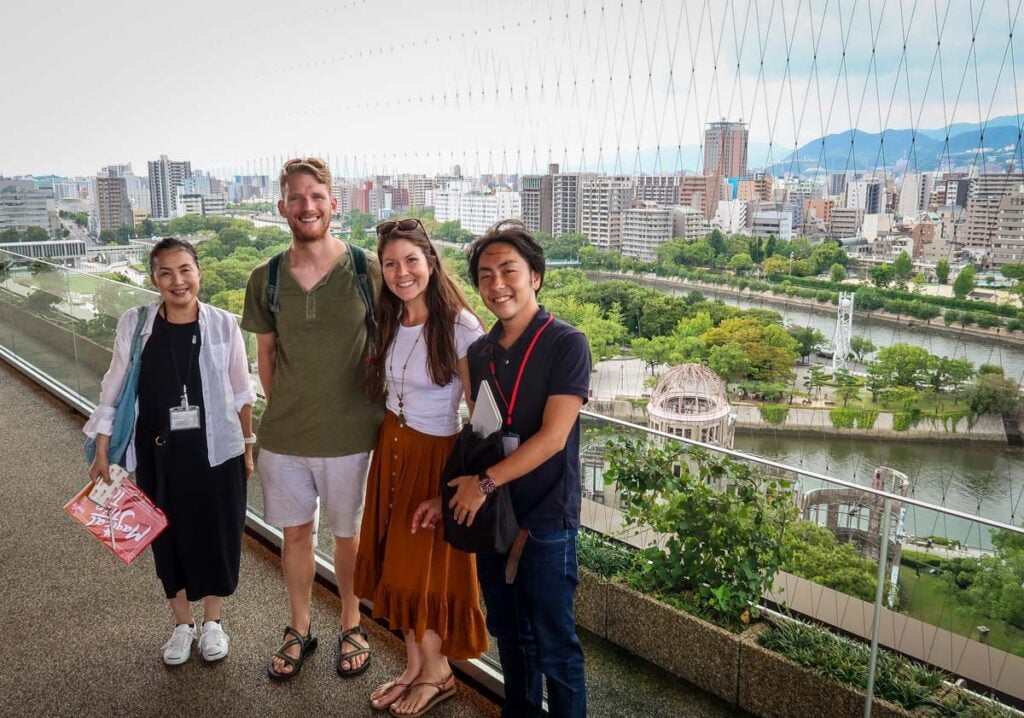
Typically we like exploring places independently so we can go at our own pace.
When we heard Magical Trip offered a Hiroshima tour with a local guide, we booked it thinking we’d be able to ask lots of questions and get all sorts of insider info.
It could be a good option if you don’t want to wander on your own.
Our personal experience: I’m going to be totally honest and say that we felt the guided tour was unnecessary in this case. Our guides were very sweet, but other than a few facts, we didn’t learn all that much more than we would have on our own. And we didn’t really get the insider stories that we were hoping for.
There are many signs around the city that are in English, and the major WWII sites are all very walkable. So unless you really want someone to lead you around, you’ll be totally fine exploring Hiroshima on your own.
What to eat in Hiroshima
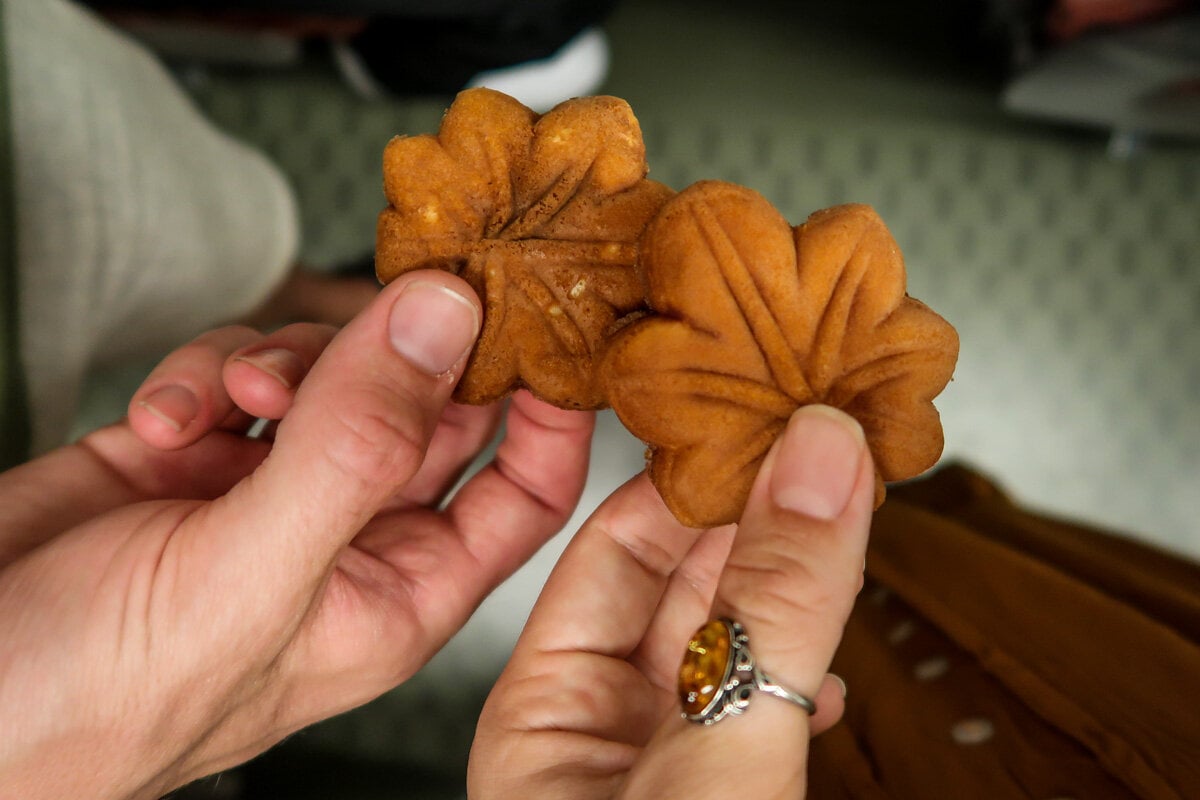
While traveling in Japan, you’ll soon find out that each region has its own specialties that locals take pride in and travelers — both domestic and foreign — are compelled to taste.
When it comes to the regional cuisine in Hiroshima, there are a few dishes they are especially proud of…
Psst! If you haven’t already checked out our guide to Japanese cuisine, bookmark it for later because it’s packed with info!
Hiroshima-style Okonomiyaki
This version is quite a bit different than the traditional Osaka-style okonomiyaki, as it includes yakisoba noodles. Plus, instead of being mixed together as it is in Osaka, the Hiroshima version is cooked in layers. Hiroshima locals are very proud of this dish and are often quick to tell you about its superiority to the version served by their northern neighbors.
Where to try it:
- Okonomiyaki Teppan-yaki Momiji-Tei: small eatery with manga theme
- Nagataya: famous okonomiyaki spot with vegan options
- Okonomimura: food hall with lots of okonomiyaki stands to choose from
Oysters
This region is responsible for two-thirds of all the oysters in Japan! So if you’re a seafood lover, belly up to an oyster bar for some freshly shucked goodness.
Momiji Manju
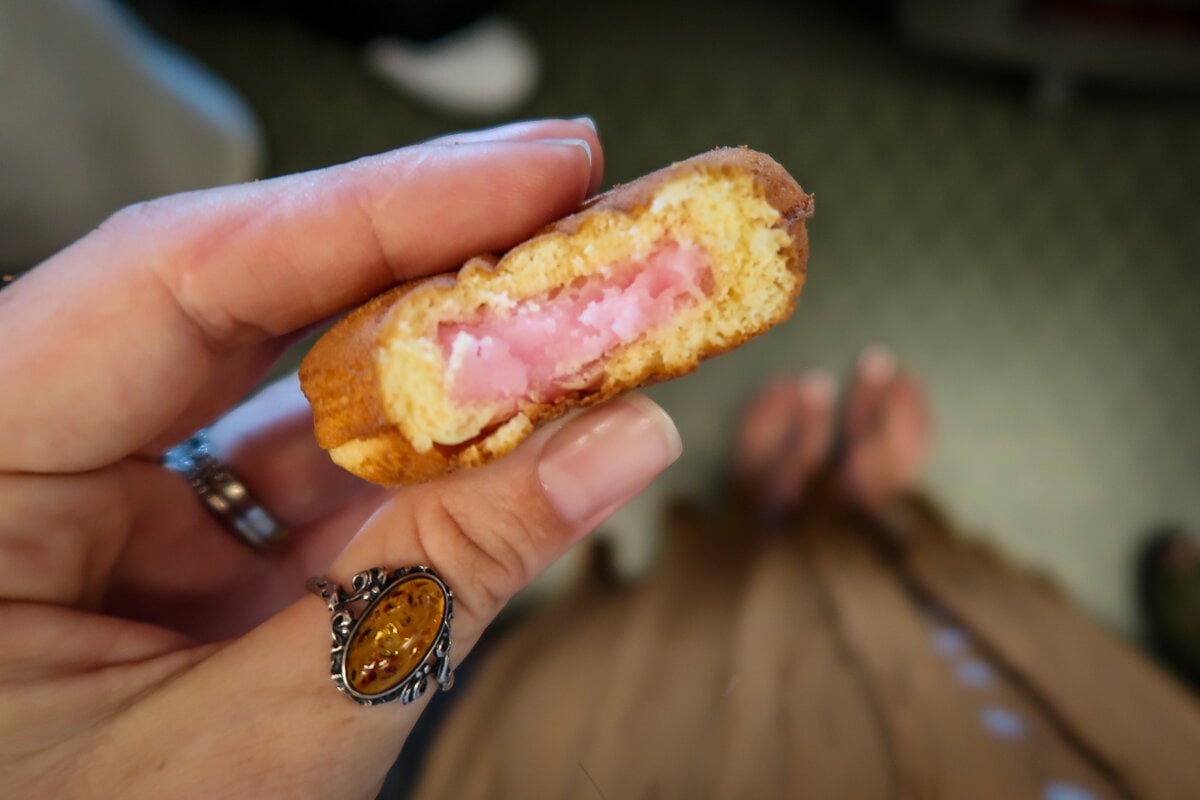
Manju is a type of Japanese cake filled with red bean paste. This style from Miyajima Island is in the shape of a maple leaf (momiji), and is a local specialty that you can find both in Hiroshima and Miyajima.
Hiroshima Tsukemen
Tsukemen means ‘dipping noodles’, and is a type of ramen where the noodles and the broth are served separately, so you can dip each bite, as the name suggests. While you can find this dish all over the country, Hiroshima has a regional spin on tsukemen.
Not only are the noodles served separately from the broth, but in the “Hiroshima-style” of tsukemen ramen, the broth is cold and spicy. While it may sound strange to ramen traditionalists, this cold noodle soup is particularly nice in Japan’s hot and humid summer months.
Where to try it:
- Tsukemen Karabu Tokaichimachi
- Alternative: Okkundou Mazemen – similar to tsukemen, mazemen ramen noodles are served brothless (with a sauce instead), and the noodles are thicker
Getting around Hiroshima
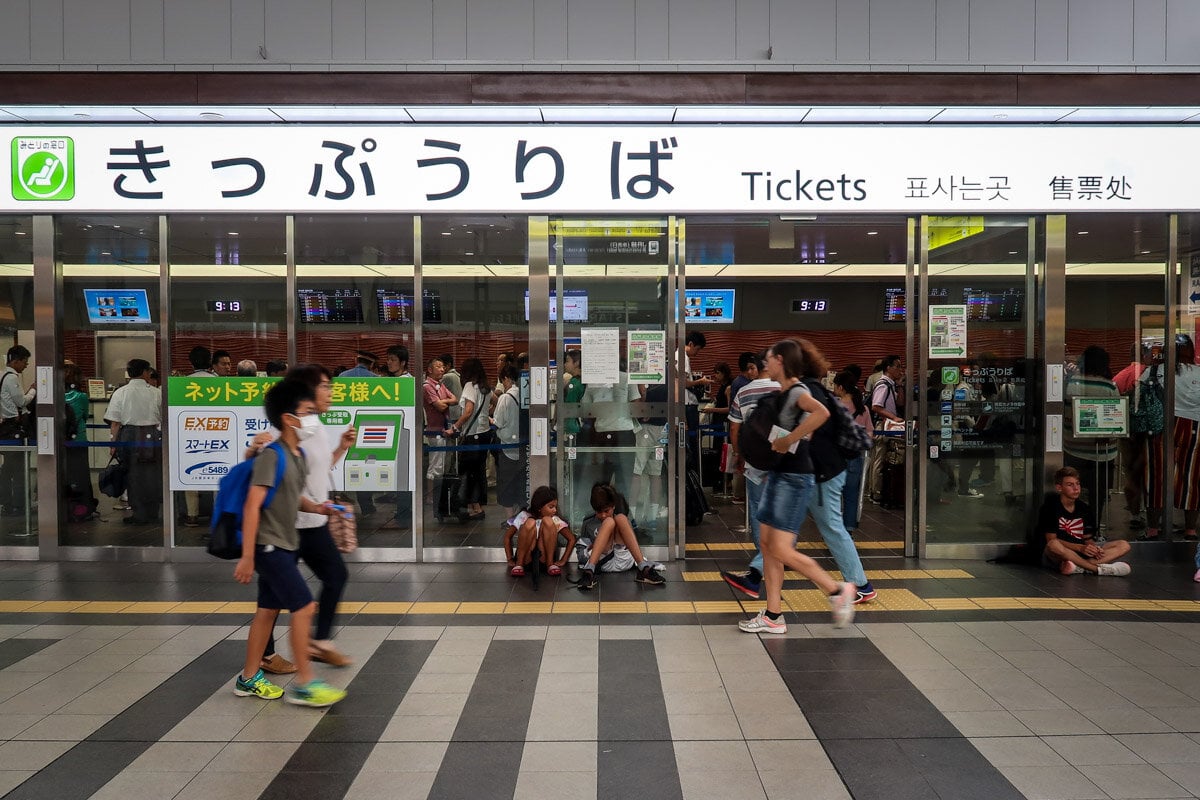
Getting to and from Hiroshima is covered in your JR Pass, and getting around within the city can be paid for with an ICOCA transport card.
The best way to get downtown (to the historic sites) from Hiroshima Station is to exit the train station and take the streetcar tram. It costs 180 yen per ride and you can use an ICOCA card.
If you’re headed to the WWII sites, get out at Genbaku Dome-Mae and exit from front or back door (not the middle) and tap your ICOCA card.
Insider Tip: Keep an eye on your GPS location on Google Maps so you know when to get off, as it is a little tricky to see the stop names.
This stop is right by the Atomic Bomb Dome, and is a good place to start your DIY Walking Tour!
How to get to Hiroshima from Kyoto or Tokyo
We’ll share how to get to Hiroshima from other nearby cities in Japan, in case you want to change up your route.
Kyoto to Hiroshima
You can travel from Kyoto to Hiroshima on the shinkansen train lines as well. A direct journey between the two stations (Kyoto Station and Hiroshima Station) will take about 1 hour and 40 minutes.
However, if you are using your JRail Pass, you will have to book Hikari or Sakura services (Nozomi services are not included in the pass) and you may have to transfer at Osaka Station or Kobe Station. The good news is, this will only add 10-15 minutes to your total journey. Without the pass, you can expect to pay over ¥10,500 (about $100 USD) for a ticket to Hiroshima from Kyoto.
Tokyo to Hiroshima
You can use your JRail Pass to take the Tokaido-Sanyo Shinkansen train from Tokyo to Hiroshima.
You’ll book a ticket from Tokyo Station and stop in either Osaka Station, Kobe Station or Himeji Station. The entire trip, including transfer, takes about 5 hours in total from Tokyo and will cost you upwards of ¥18,000 if you don’t have the JR pass.
Another option is to take a 90-minute flight on one of several domestic airlines connecting Tokyo to Hiroshima. The flight will cost you around ¥25,000 so a JRail Pass is easily your most cost-effective option. Especially if you plan to visit other destinations while in Japan.
Where to Stay in Hiroshima
Have extra time to spend in Hiroshima? Consider spending a night (or two!), and you’ll see that this city is much more than the site of the infamous WWII bombing.
If you choose to spend the night, there are a few central neighborhoods we’d recommend finding accommodation in.
- Central Hiroshima: This is where you’ll find all of the WWII sites on our list. It is also very walkable and can easily be explored by foot. It’s also very connected to other parts of the city via public transportation.
- Hiroshima Station: Situated northeast of the city center, this will be your entry point into the city if you are coming by train. A good place to stay if you have an early morning departure planned.
- Yokogawa: One of the few places in Hiroshima that has retained its township status, Yokogawa has a much more laid back feel with plenty of dining options. During the pre WWII era, this used to be the city center. Today you’ll find a nice mix of residential, restaurants and alternative shops.
- Miyajima Island: Being such a popular tourist destination, there is something special about staying overnight once all of the day tourists have left. With ferries operating regularly, you should have no problem getting back into the city to explore.
Budget stays in Hiroshima
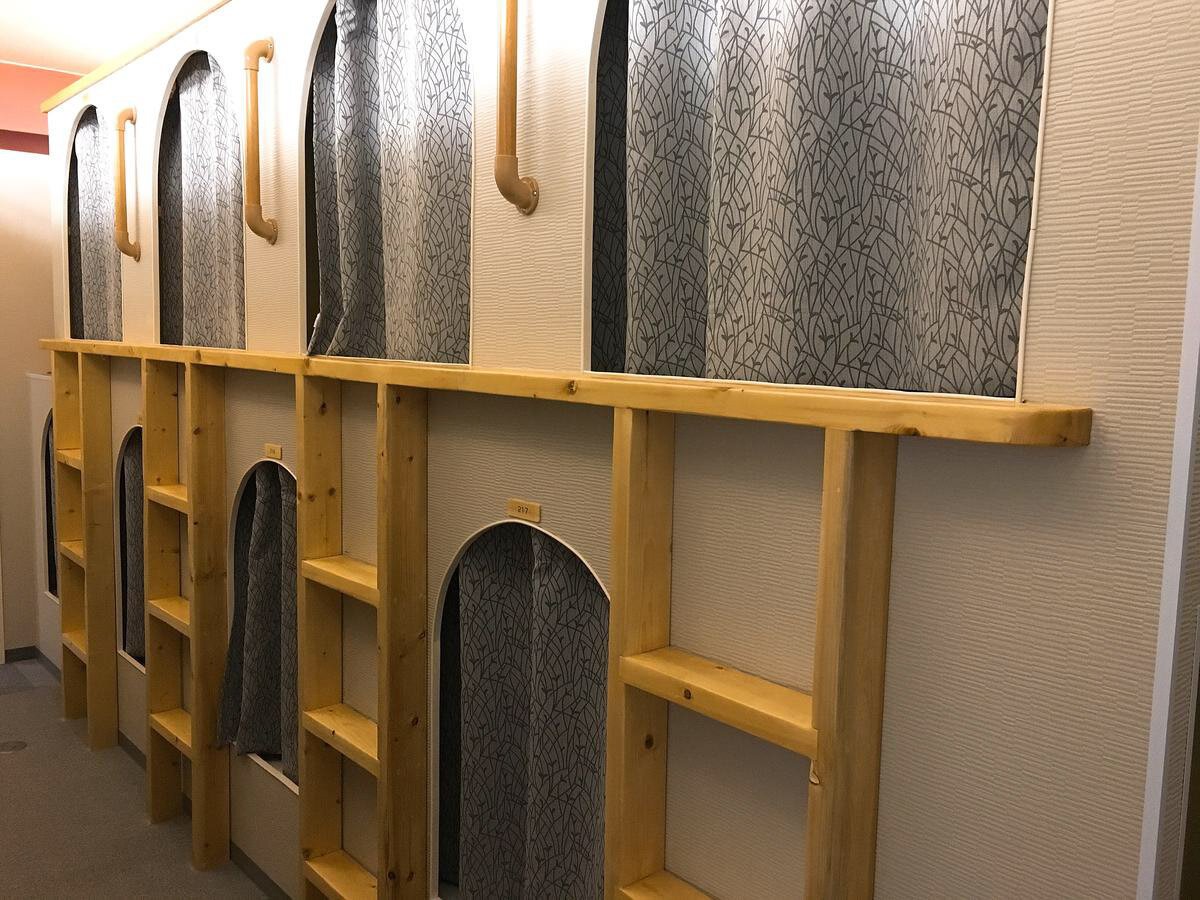
Hostel Mallika – Situated in the the Hiroshima City Center, this hostel is in walking distance from Peace Park and all the WWII sites. They have pod-style beds available in mixed dorms as well as triple and quadruple rooms — perfect for travelers coming in a group.
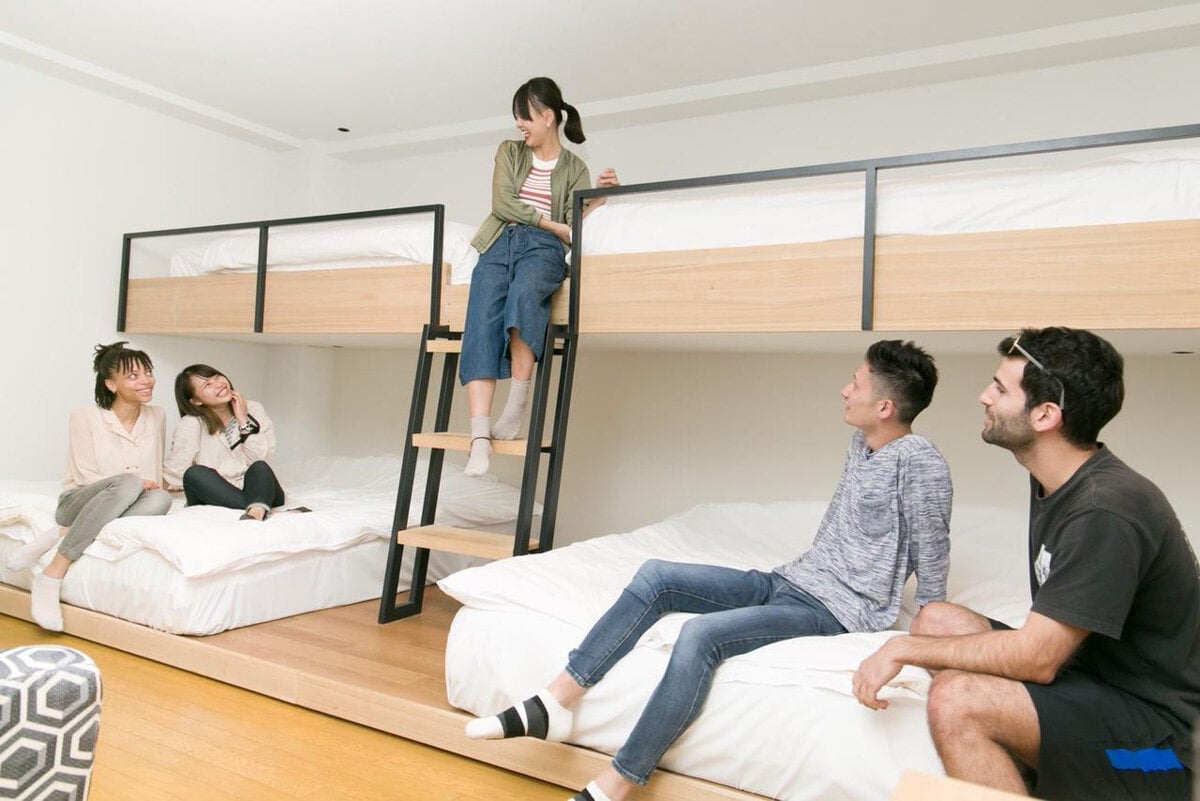
Santiago Guest House – This centrally located guesthouse offers a range of accommodation from hostel-style dorms to private rooms and even family rooms. A shared kitchen, lounge and free WiFi throughout the property round out the amenities.
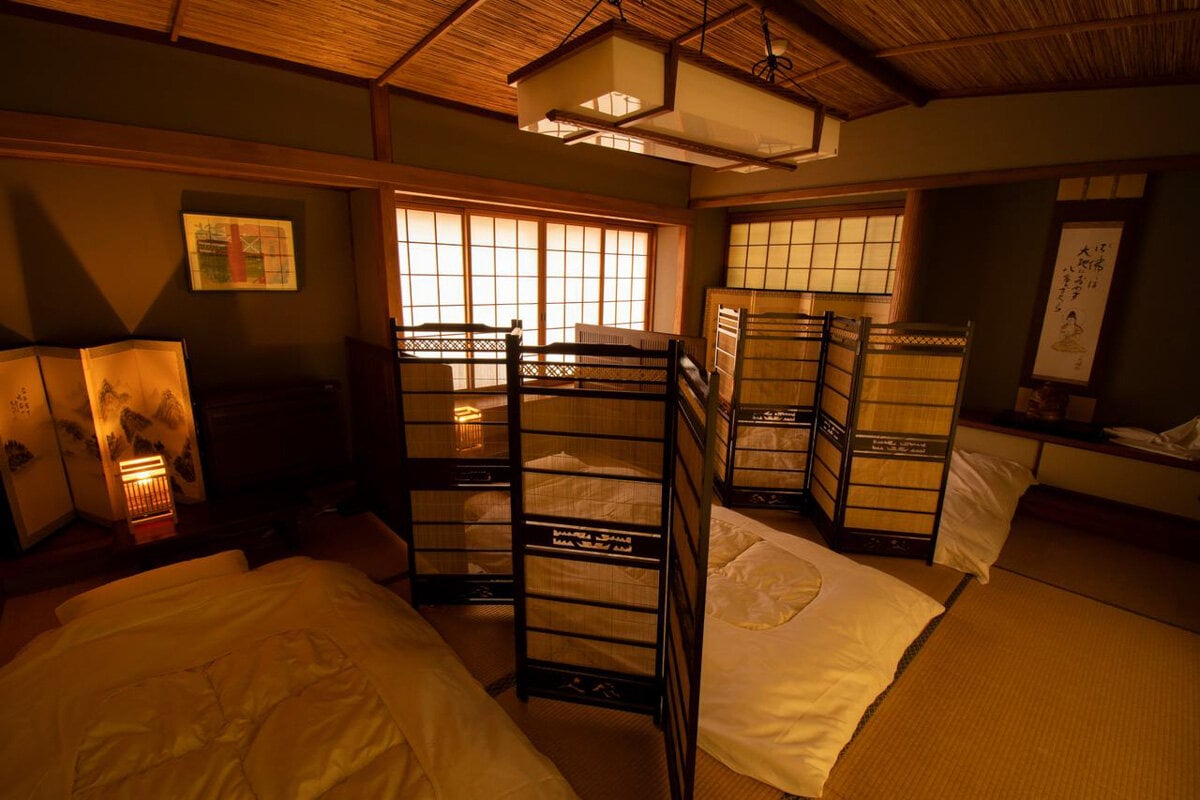
Miyajima Guesthouse Mikuniya – This traditional Japanese guesthouse is located on Miyajima Island. The property comes highly rated by reviewers and the service is top notch. They offer single and shared rooms in the traditional Japanese style (floor beds) and a shared bunk dormitory.
Mid-range/couples stays in Hiroshima
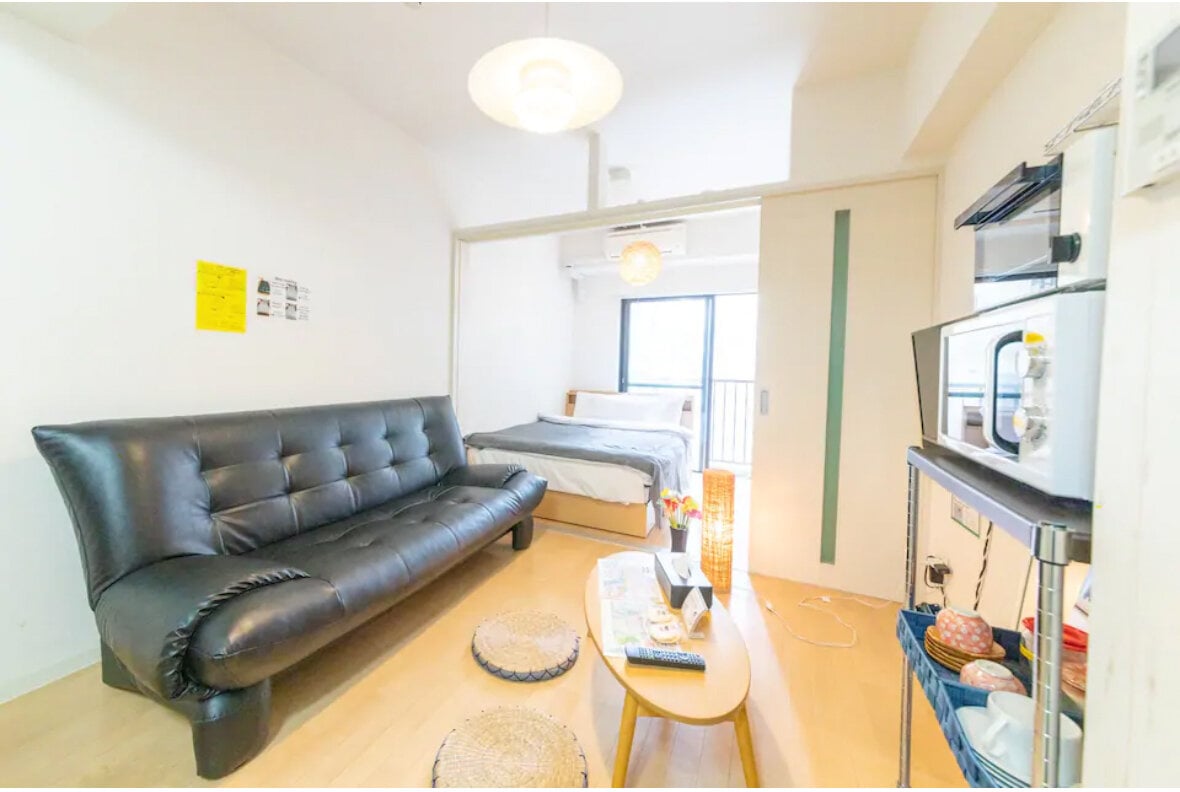
Airbnb: 1 min to Dome & Peace Park & Center Hiroshima – This private 1 bedroom apartment is located in the city center, just a 1 minute walk to Peace Park and the other WWII sites. Other amenities include a full kitchen, wifi and air conditioning. Check Availability.
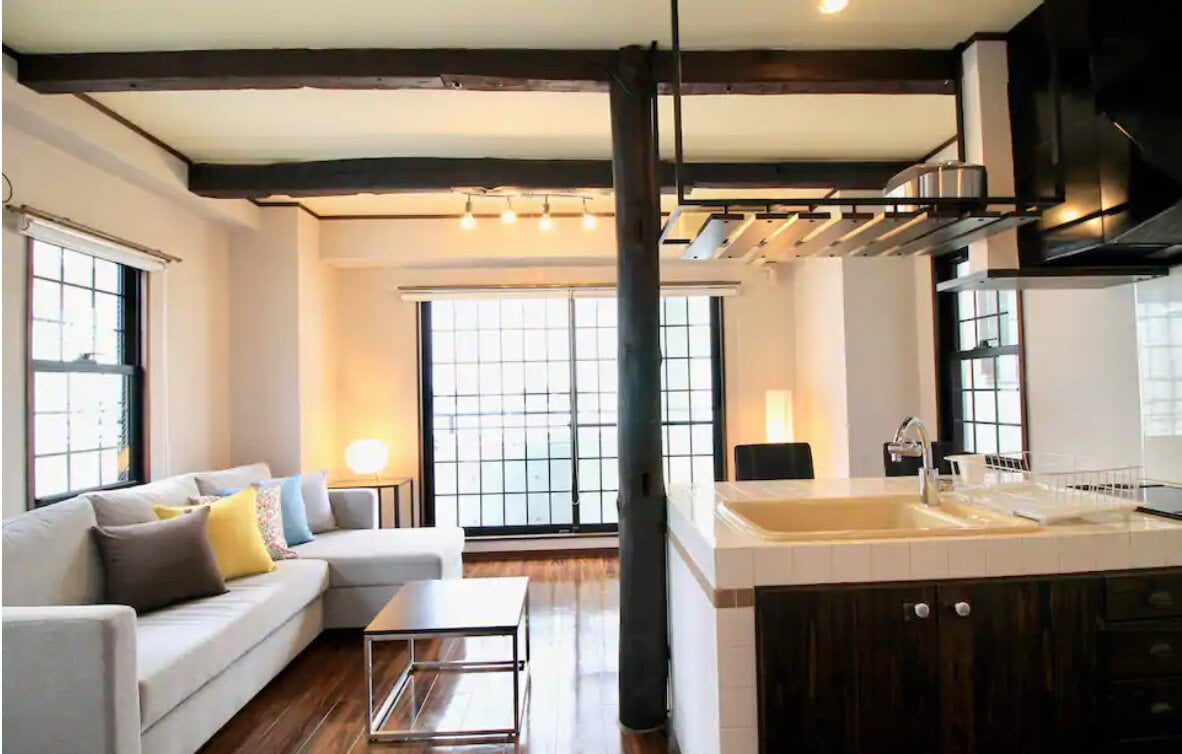
Airbnb: 30sec walk to PeacePark, Beautiful Condo – B – This private apartment is centrally located near the shopping streets in Hondori. It is also just a few minutes walk from Peace Park. The 1 bedroom apartment sleeps up to 5 guests and includes a kitchen, laundry, wifi and AC. Check Availability.
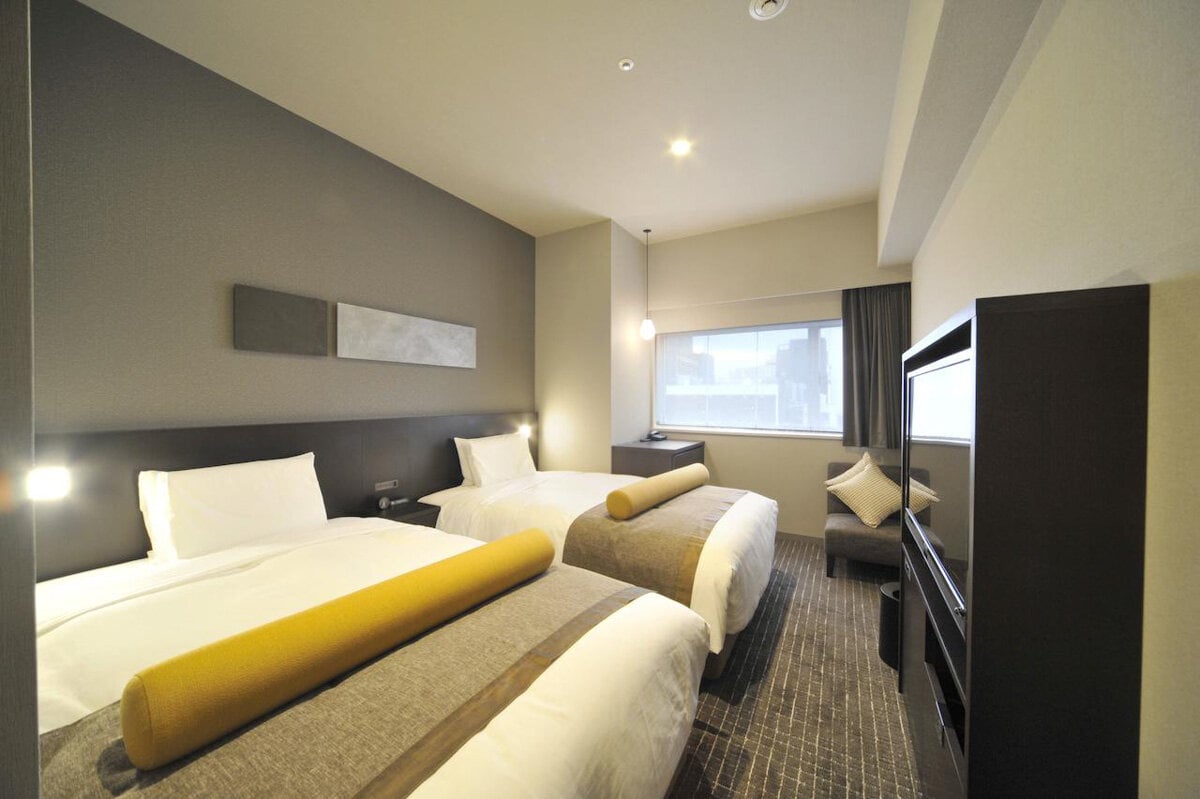
Hiroshima Washington Hotel – This centrally located hotel is just a 5 minute walk from Hatchobori Tram Station and 15 minutes to the Peace Park. As well as easy access to shop and restaurants. The property comes highly rated and features air conditioned rooms in an elegantly decorated space.
Splurge/Luxury stays in Hiroshima
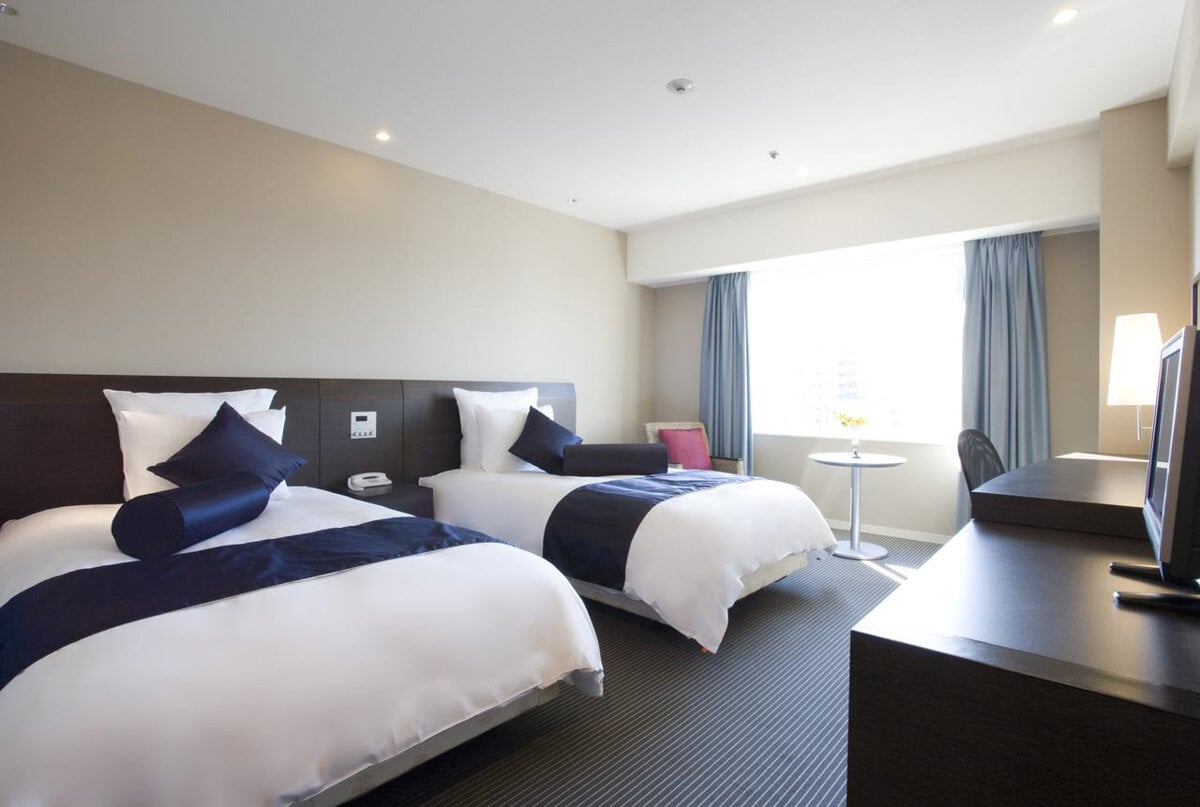
ANA Crowne Plaza Hiroshima – Situated just 5 minutes from Peace Park, the elegant ANA Crown Plaza hotel features an in house restaurant, salon spa and fitness center with swimming pool.
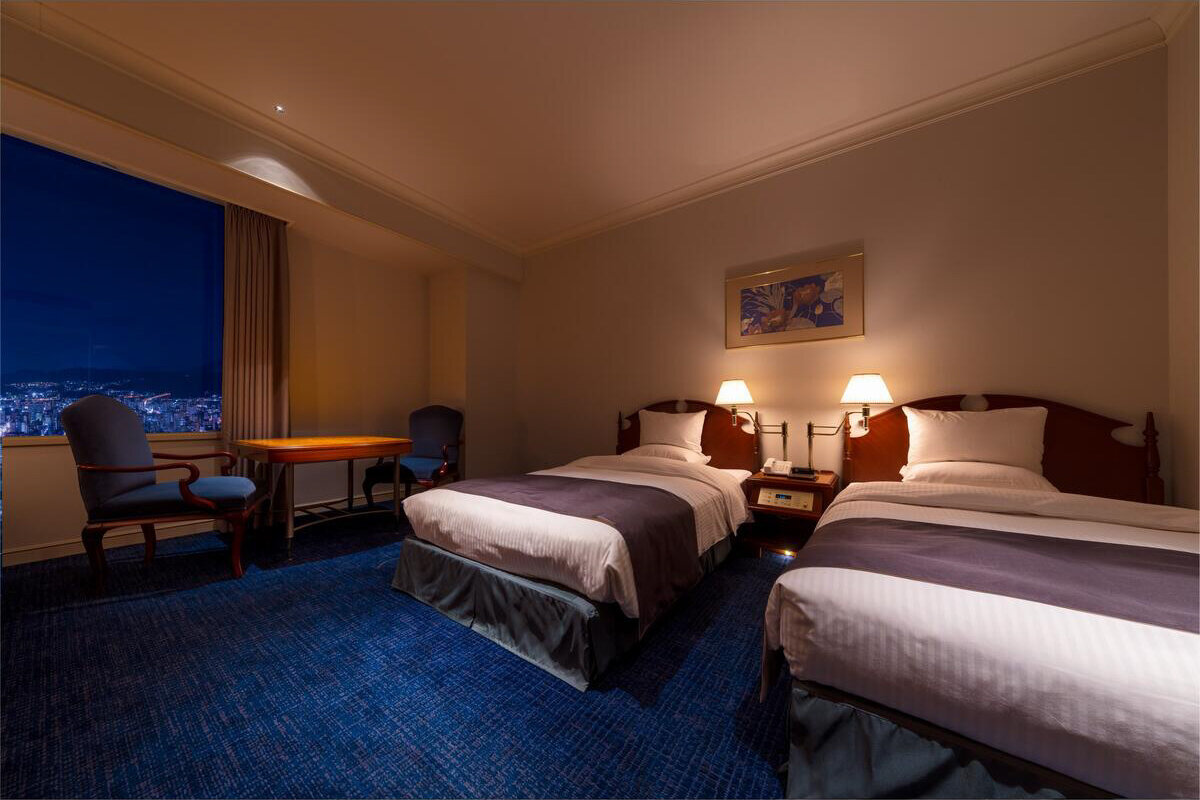
Rihga Royal Hotel Hiroshima – Just a 5 minute walk to Peace Park, this luxurious hotel features 5 different dining options and a fitness center with swimming pool. Guest rooms are complete with Serta mattresses, and the ensuite includes a bathtub.
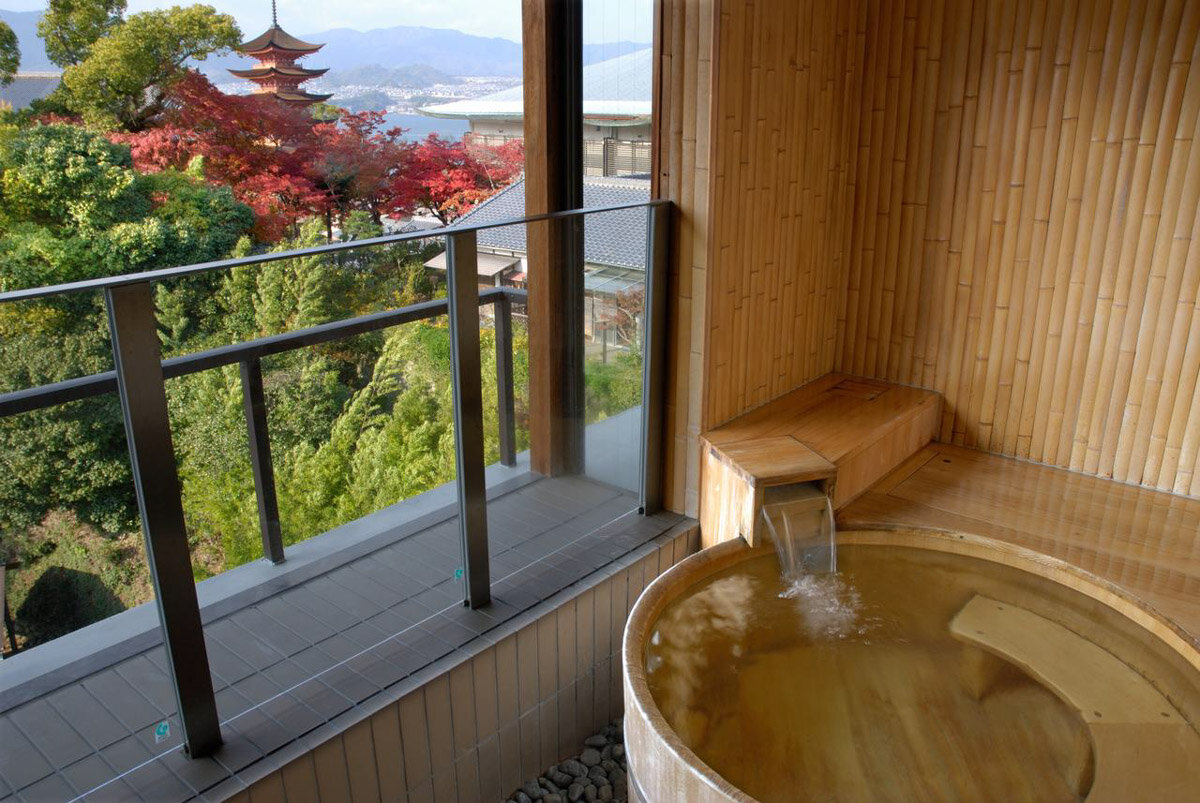
Miyajima Grand Hotel Arimoto – Situated on Miyajima Island, just a 3-minute walk from the Itsukushima Shrine, this hotel offers luxurious Japanese and Western-style rooms. The property features an outdoor hot spring bath, 3 restaurants and karaoke rooms.
Plan your trip to Japan
After 3 trips (and counting!), we’ve fallen head over heels for Japan—and we’ve created TONS of resources to help you plan your dream trip. Start with our Ultimate Japan Travel Guide and be sure to check out these helpful articles:
- First time? Our Japan Trip Planner walks you through everything you need to know.
- Use our Japan Rail Pass guide to determine if getting a train pass is optimal for your trip.
- Here’s our curated list of the best things to do in Japan—from iconic sights to once-in-a-lifetime experiences.
- Not sure where to go? Our Japan itinerary ideas will help you map it all out.
- Foodies, rejoice! This guide to what to eat in Japan will have you drooling before you land.
- This guide to what to wear in Japan (and what not to wear) will help you blend in.
- Use our ultimate Japan Packing List to make sure you don’t forget anything.
- Before you go, brush up on these essential Japan travel tips (including major do’s and don’ts!).
- Avoid awkward moments by brushing up on Japanese etiquette.
Still have questions? Drop us a comment—we LOVE helping travelers plan unforgettable trips to Japan!
Perfect Japan itinerary
Want the perfect itinerary planned for you?

If you don’t have a ton of time to spend planning your Japan itinerary (or you just don’t find travel planning fun), we’ve got something you might be interested in…
We created the ultimate done-for-you Japan itinerary that is packed full of all sorts of tips we’ve gathered from 3 trips to Japan as well as literally hundreds of hours of research (no exaggeration).
We have both an off-the-beaten path route as well as a classic itinerary that hits the top attractions (perfect for your first visit to Japan!).
Don’t miss your chance to grab our Japan Pocket Guide!
This (totally FREE!) pocket guide is a condensed version of all the things you should know BEFORE & DURING your trip to Japan!
Just enter your email and we’ll immediately send our pocket guide straight to your inbox!
Save this article on Pinterest for later!
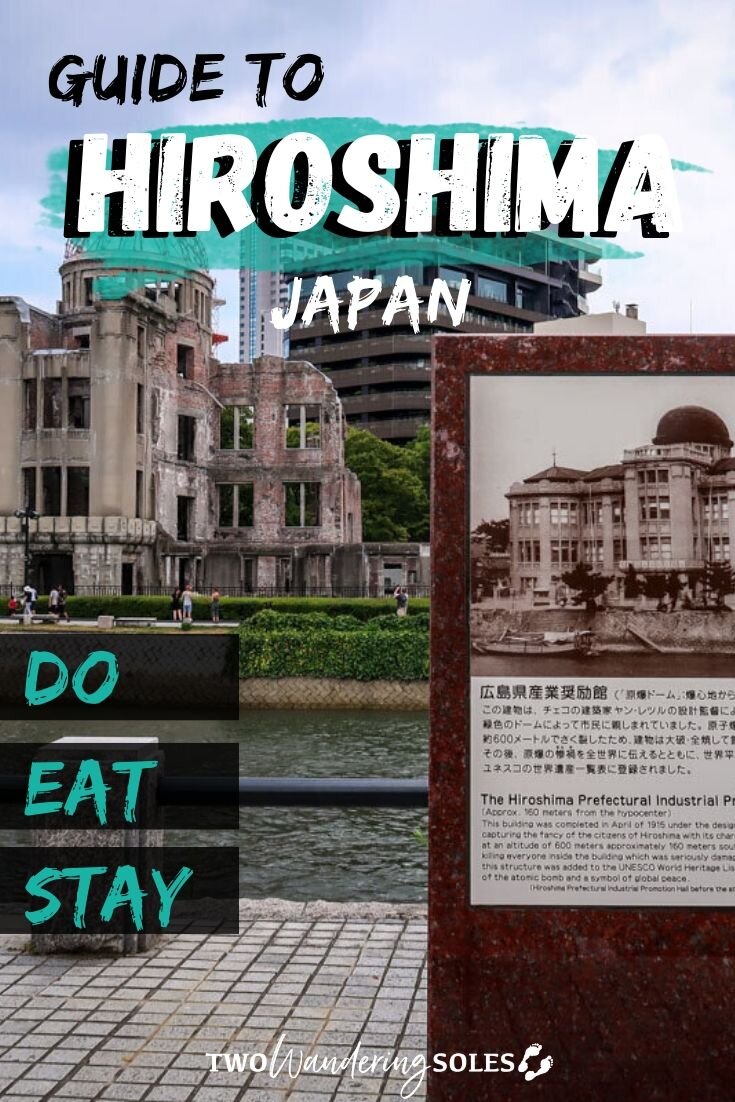
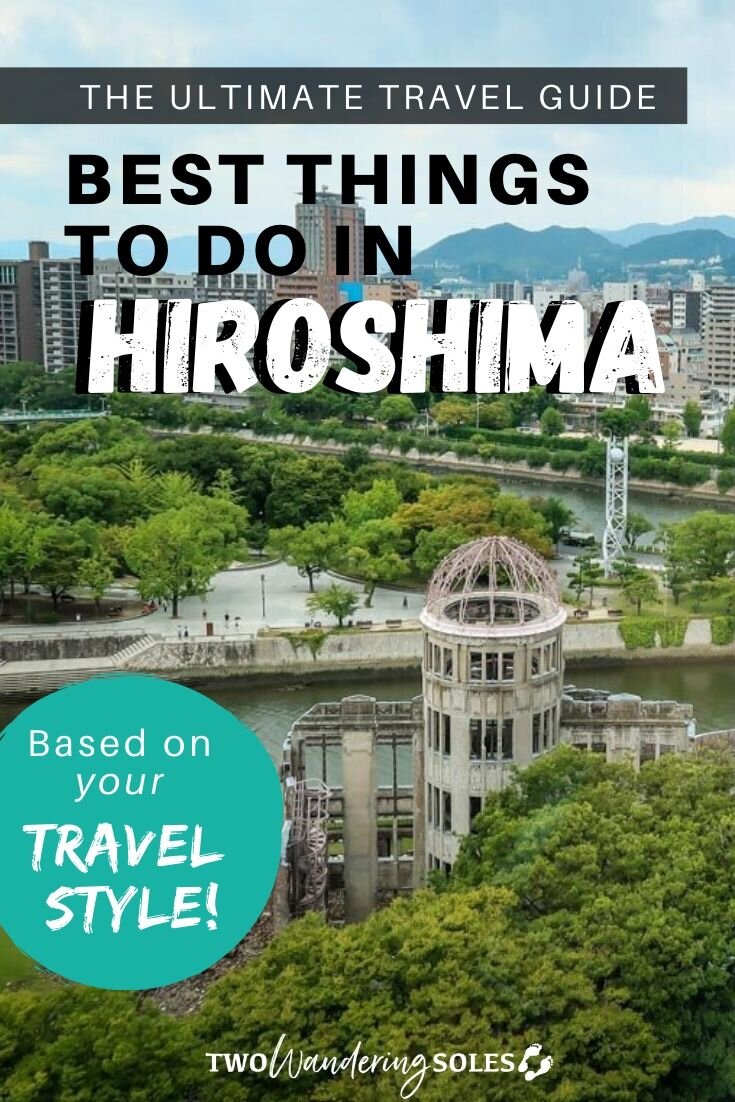
We want to hear from you!
Have you ever been to Hiroshima? What was your experience like? Do you have any suggestions you think we left off this list?
Are you planning a trip to Hiroshima and still have questions? Comment below and we’ll do our best to get back to you!

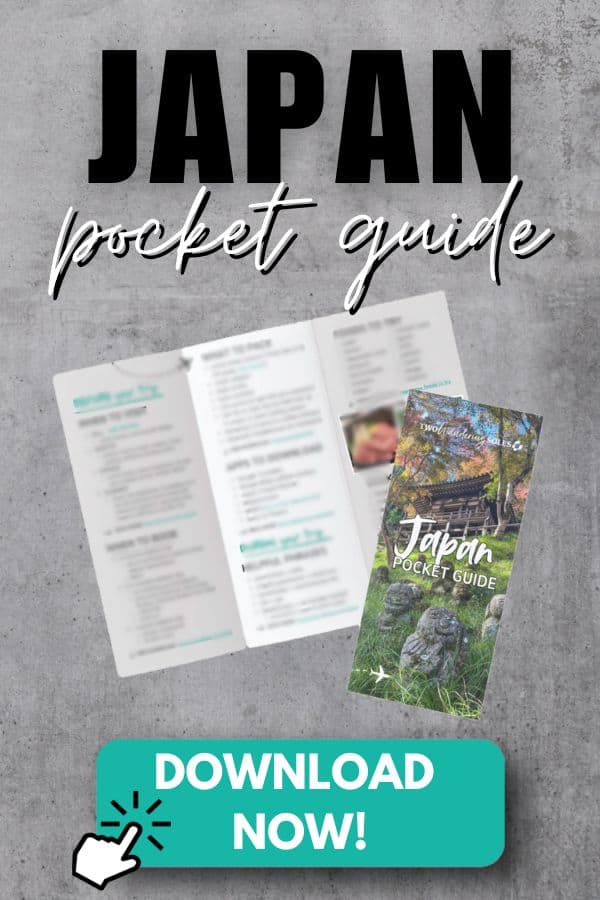
this is great thanks
We are going to do a one-day visit Hiroshima on Feb 3, 2024. Can we go to the Miyajima Island first then to do rest in your list? We will be coming from Osaka. Thank you.